Home Decor & Design
Japandi-Style Coffee Table That'll Zen Up Your Living Room
Yearning for a peaceful retreat in your living room? Discover how a Japandi-style coffee table can effortlessly infuse serenity and style into your space.
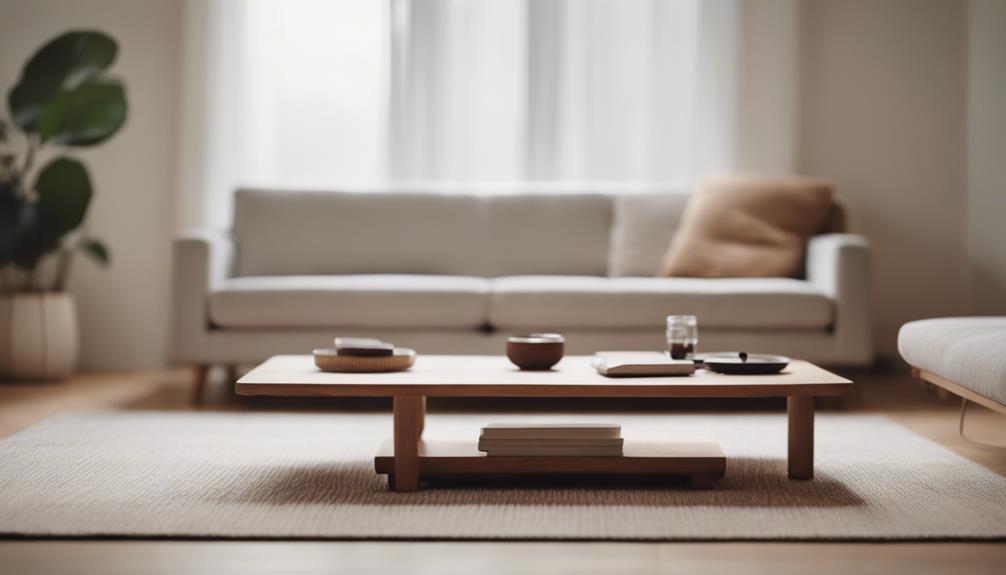
Transform your living room into a serene sanctuary with a Japandi-style coffee table. Infuse Japanese calmness and Scandinavian simplicity for a zen living space. Embrace earthy textures, blend angular details with wood elements, and add greenery for balance. Opt for a retro vibe with slanted legs and wood-paneled sides. Decorate with a decorative tray featuring staggered decor for visual interest. Achieve cozy elegance with warm-colored wood. Enhance the inviting atmosphere, create a harmonious fusion, and elevate your decor effortlessly.
Key Takeaways
- Incorporate round woven floor poufs for texture and seating options.
- Combine angular details with wood textures and greenery for balance.
- Opt for a coffee table with slanted legs and wood-paneled sides for a retro vibe.
- Arrange a decorative tray with staggered decorations and varied heights.
- Choose warm-colored wood coffee tables for a sleek coziness.
Styling Ideas for Japandi Coffee Tables
Enhance the aesthetic of your Japandi coffee table by incorporating round woven floor poufs for texture and additional seating options. These poufs not only add a cozy element to your living room but also complement the minimalist design of a Japandi-style coffee table.
By combining angular details with wood textures and greenery, you can create an earthy and inviting feel around your coffee table.
To achieve a Japandi retro vibe, consider a coffee table with slanted legs and wood-paneled sides for that perfect vintage touch. Additionally, arranging decor like a decorative tray with staggered decorations and varied heights will add visual interest to your Japandi-inspired space.
For a sleek coziness, opt for a warm-colored wood coffee table paired with off-white decorations and angular details, paying homage to traditional Japanese decor within a minimalist setting. Incorporating these styling ideas will elevate the overall look and feel of your living room with a Japandi coffee table as the centerpiece.
Earthy & Inviting Coffee Table Decor
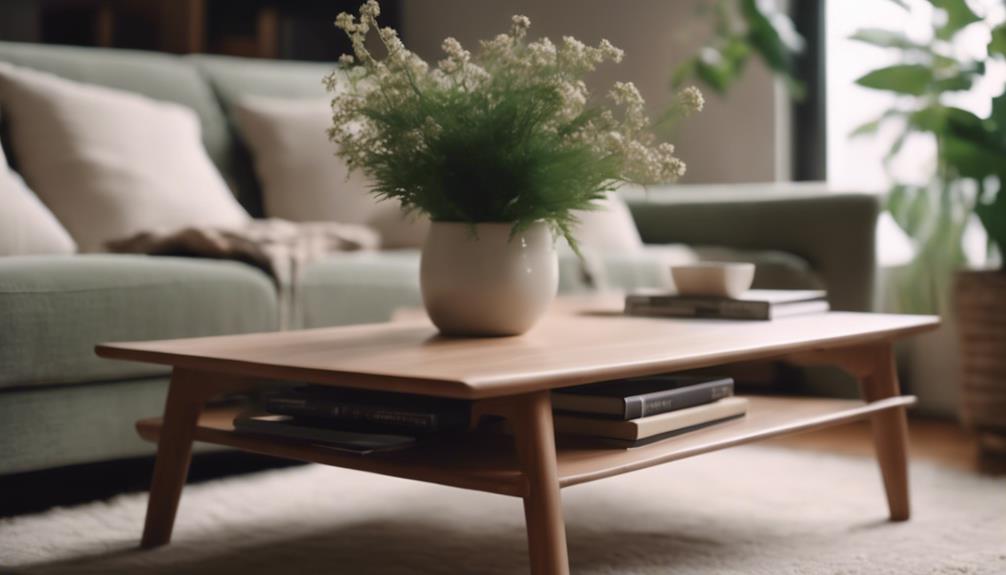
To create an earthy and inviting ambiance around your Japandi coffee table, consider incorporating natural elements like wood textures and greenery.
By blending Japanese and Scandinavian design elements, you can achieve a harmonious balance between the two styles.
Opt for a coffee table with angular details paired with a potted bonsai tree to add a friendly and welcoming touch to your living space.
Embrace the use of plenty of wood textures and greenery to create an earthy aesthetic that exudes warmth and tranquility.
This decor theme focuses on clean lines and minimalism, emphasizing natural materials to enhance the overall charm and inviting atmosphere of the room.
The Japandi-inspired decor style brings a sense of calm and simplicity, making it a perfect choice for those seeking a cozy and relaxing environment in their home.
Japandi Retro Table Inspiration
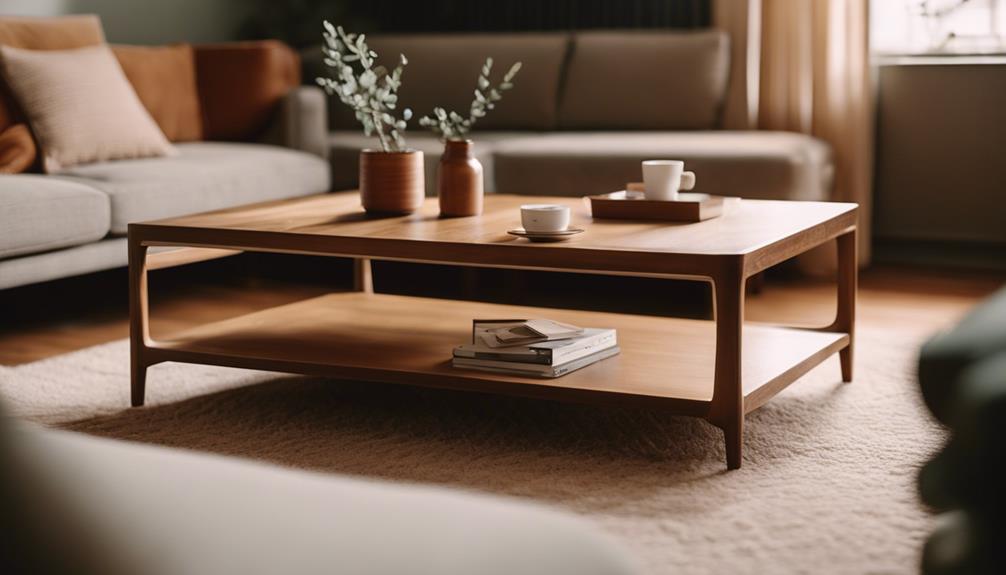
Consider infusing your living space with a touch of nostalgia and modern flair by exploring Japandi retro table inspiration.
Retro-inspired Japandi coffee tables effortlessly blend Japanese design elements with retro-inspired aesthetics, creating a harmonious fusion of styles.
Here are three key features to look out for when seeking Japandi retro table inspiration:
- Vintage Vibes: Look for tables with slanted legs and wood-paneled sides that evoke a sense of nostalgia reminiscent of 1950s and 60s interior design.
- Modern Accents: Opt for tables that incorporate modern black and white accents to add a contemporary twist to the retro design, creating a unique and eye-catching piece.
- Balanced Blend: Seek tables that seamlessly combine Japanese and Scandinavian styles, striking a perfect balance between the two aesthetics to create a visually appealing and functional piece for your living room.
Intentional Decor Placement Tips
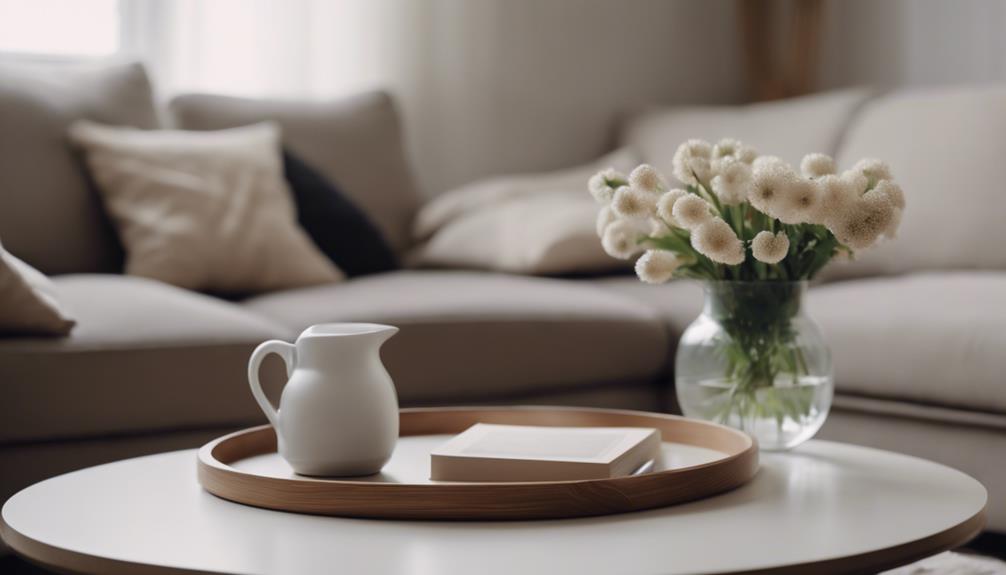
When decorating your space, consider using a decorative tray to corral smaller decor items and create a cohesive look.
Experiment with staggering decorations of varying heights to add visual interest and depth to your coffee table display.
Strategic Decor Arrangements
For a harmonious Japandi-style decor arrangement on your coffee table, focus on strategic placement of your decorative items to enhance the overall aesthetic appeal. To achieve this, consider the following tips:
- Incorporate Natural Materials: Choose decor pieces made of natural materials like wood, bamboo, or stone to bring an organic and earthy feel to your coffee table. Opting for items with clean lines and simple shapes will complement the Japandi style's minimalistic approach.
- Utilize Staggered Decorations: Arrange your decorative items in a staggered manner to create visual interest and depth. This technique not only adds a sense of balance but also draws the eye to different focal points on the table.
- Play with Height Variety: Incorporate decor pieces of varying heights to add dimension and a dynamic aesthetic to the space. Mix taller items like vases or sculptures with smaller elements to create a visually appealing arrangement that captures attention.
Remember to maintain a soft neutral color scheme to uphold the calming and cohesive atmosphere characteristic of Japandi decor.
Visual Interest Techniques
Incorporate ornamental trays on your coffee table to provide a designated space for smaller decor pieces, enhancing the intentional placement and visual appeal of your Japandi-style arrangement.
To elevate the visual allure, try staggering decorations in varying heights to create a dynamic and enchanting look.
Integrate a mix of textures and materials such as wood, ceramic, or stone to add depth and complexity to your decor arrangement.
Opting for a soft neutral color palette will help maintain a calming and cohesive space while allowing natural elements like plants or pebbles to bring a touch of the outdoors inside.
Experiment with different heights and shapes when placing your decor items to achieve a well-balanced and intentional arrangement that reflects the minimalist yet warm essence of Japandi style.
Sleek Coziness in Coffee Table Design
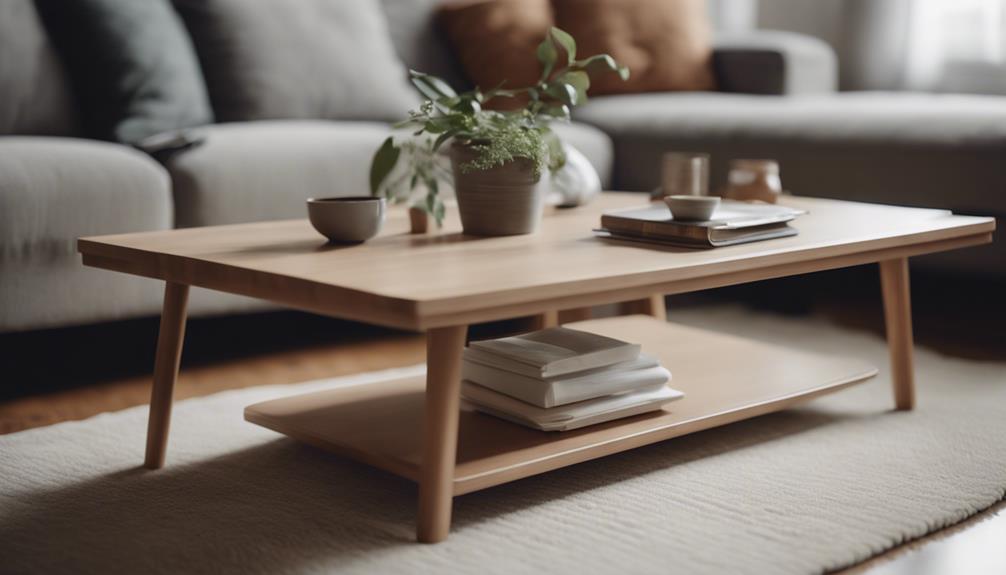
To achieve sleek coziness in your coffee table design, consider incorporating angular wood details for a touch of traditional Japanese aesthetics.
Soften the look with off-white decorations that create a harmonious balance with warm wood tones, emphasizing simplicity and elegance.
The minimalist approach guides the design, ensuring a blend of warmth and modernity in your living space.
Angular Wood Details
Angular wood details infuse a sense of sleek coziness into the design of a Japandi-style coffee table.
The combination of sleek design and warm wood tones creates a visually appealing piece that balances modernity with comfort.
Here are three key points to contemplate:
- Modern Appeal: The angular wood details incorporated into the sleek design of the coffee table offer a contemporary touch that elevates the overall aesthetic of the piece.
- Cozy Ambiance: The warm-colored wood and sleek lines of the coffee table contribute to a cozy atmosphere, perfect for creating a welcoming space in your living room.
- Visual Interest: The angular accents not only add visual interest but also draw the eye, making the coffee table a focal point in the room while maintaining a sense of harmony and balance in the design.
Off-White Soft Decor
Softening the sleek angular wood details, off-white decor adds a touch of cozy elegance to the Japandi-style coffee table design. By incorporating off-white decorations on the warm-toned wood surface, a minimalist approach is achieved, emphasizing simplicity and softness. The off-white accents complement the clean lines and angular features of the coffee table, creating a harmonious balance between sleekness and warmth.
The off-white decor serves to soften the overall aesthetic of the table, adding a subtle touch of coziness to the minimalist design. This choice highlights the beauty of simplicity while enhancing the visual appeal of the furniture piece. The warm tones of the wood are accentuated by the soft off-white hues, creating a serene and inviting atmosphere in your living space.
Incorporating off-white decor on the Japandi-style coffee table not only brings a sense of sleek coziness but also elevates the overall look with its understated elegance.
Minimalist Japanese Aesthetics
Incorporating warm colored wood coffee tables with sleek details can enhance the minimalist Japanese aesthetic in your living space. The essence of Japanese aesthetics lies in simplicity and harmony, making wood coffee tables a perfect fit for achieving this design style.
Here are three key elements when embracing minimalist Japanese aesthetics with your coffee table:
- Sleek Design: Opt for a coffee table with clean lines and minimal embellishments to embody the essence of Japanese minimalism.
- Natural Materials: Choose wood coffee tables with warm tones to bring a sense of nature indoors, a fundamental aspect of Japanese design principles.
- Functional Simplicity: Prioritize functionality in your coffee table design, ensuring that it serves a purpose while maintaining a sleek and understated appearance.
Cool Minimalism Coffee Table Styling
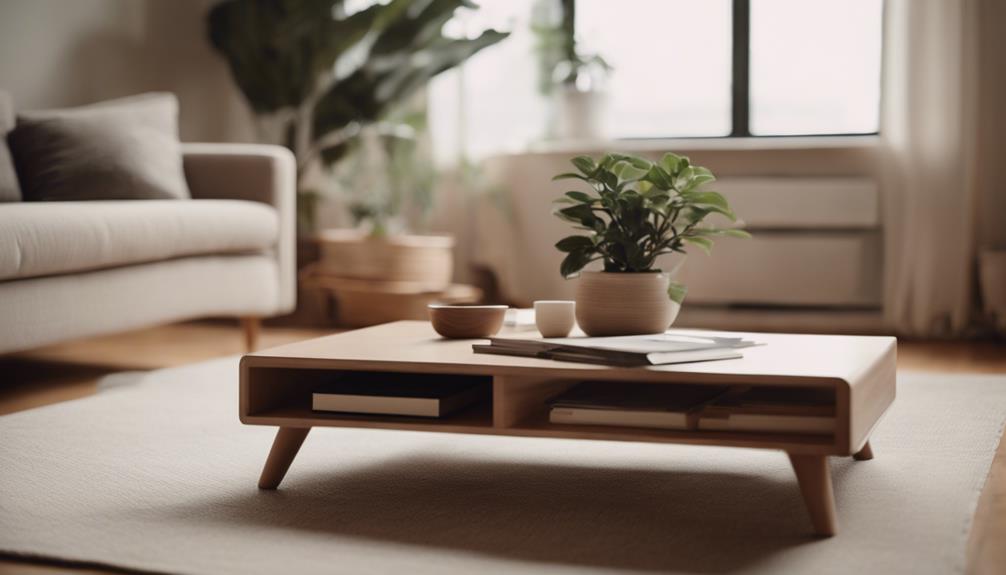
To achieve a cool minimalist coffee table styling, focus on incorporating a light wood rectangular table with dark accents for a sleek aesthetic. This blend of Japanese minimalism with Scandinavian influences creates a sleek Japanese look that embraces minimalist aesthetics.
Keep the decor minimal by adding decorative branches and books to maintain a clean and uncluttered surface. Aim for a balance between organic shapes and strict edges in the design to achieve a harmonious look.
Emphasize cool-colored and minimalist interior design elements to cultivate a serene atmosphere in your living space. For an eye-catching contrast, pair warm wood tones of the table with off-white decorations, creating a visually appealing mix of textures and colors.
Dark Furniture Coffee Table Impact
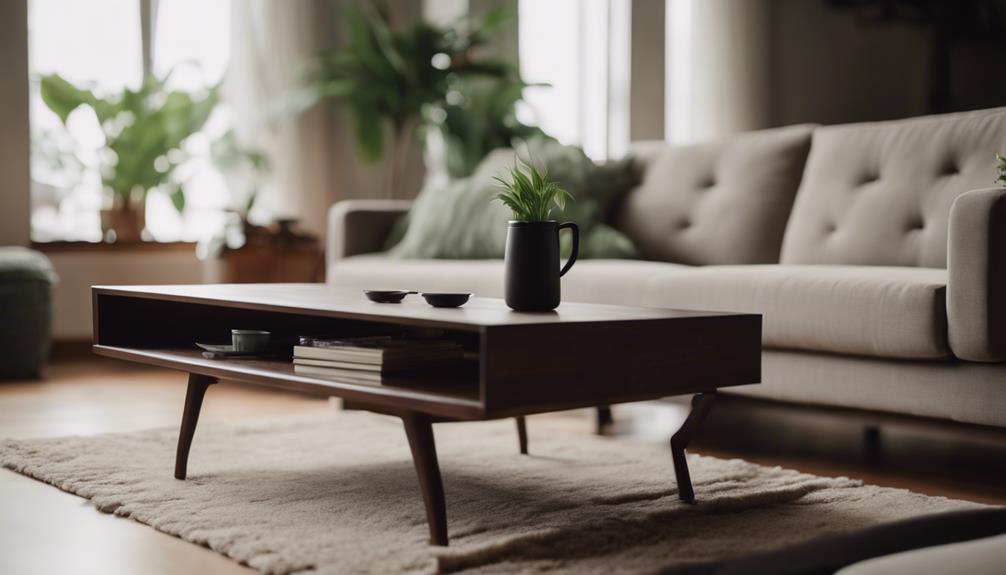
A striking visual impact is achieved in a Japandi-style living room with a gorgeous black rectangular coffee table. The contrast between the dark furniture and light accents creates a visually striking atmosphere that blends Japanese and Scandinavian design elements seamlessly.
Here's how this dark furniture coffee table can influence your living space:
- Bold Statement: The dark furniture, like the black rectangular coffee table, serves as a bold statement piece that anchors the room and draws attention.
- Contrast and Balance: The incorporation of light accents, such as off-white elements strategically placed around the room, creates a sense of contrast and balance against the dark furniture, enhancing the overall aesthetic.
- Harmonious Design: By combining dark furniture with light accents, the living room achieves a visually striking and harmonious look that exemplifies the best of both Japanese and Scandinavian design influences.
Sensory Engagement With Coffee Tables
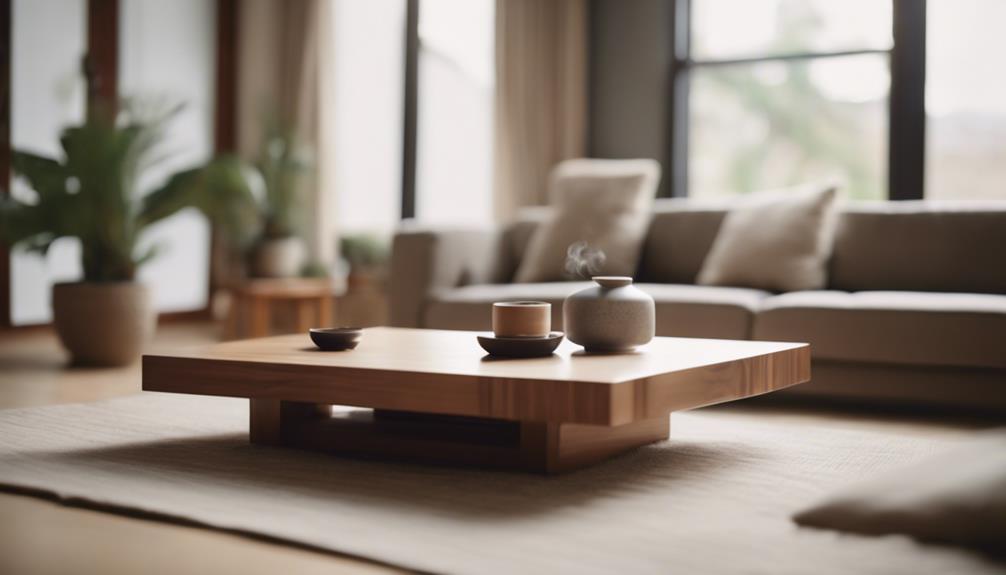
Engage your senses with thoughtful additions to your coffee table decor for a more immersive living space experience. Incorporating an incense burner not only adds a touch of tranquility to your space but also engages your sense of smell, creating a calming atmosphere.
To bring a hint of nature indoors, consider placing a potted fern or small plant on your coffee table for a visually appealing touch of greenery.
Experiment with textures like warm wood and smooth surfaces to enhance the sensory engagement of your coffee table. These tactile elements can provide a multi-sensory experience, adding depth and interest to your living room decor.
Additionally, incorporating height variations in your coffee table decorations can engage your sense of sight, creating a dynamic aesthetic that draws the eye.
For a final sensory touch, add a small decorative tray with sensory items to your coffee table. This not only enhances visual appeal but also serves a functional purpose by keeping essentials within reach while adding to the overall sensory experience of your living space.
Frequently Asked Questions
What Is the Difference Between Zen and Japandi?
You know, Zen's all about that inner peace, simplicity, and meditation. Japandi, on the other hand, mixes Japanese and Scandinavian vibes for a cozy minimalism with a modern twist. It's like Zen with a Nordic hug!
What Is the Difference Between Wabi-Sabi and Japandi?
Incorporate wabi-sabi into your space for a celebration of imperfection and nature's beauty. Embrace Japandi's fusion for a harmonious blend of Japanese simplicity and Scandinavian minimalism. Find balance in asymmetry and order in a cozy, clutter-free living area.
How Do You Style a Coffee Table in a Living Room?
When styling a coffee table in your living room, balance function and aesthetics by considering size, shape, and storage options. Mix textures for visual interest and personalize with books, candles, or decor reflecting your style for a cohesive look.
What Is the Difference Between Chabudai and Kotatsu?
Chabudai focuses on communal dining with a low table for gatherings. Kotatsu provides warmth and coziness during winter with a heated low table covered by a blanket. Both offer unique aspects of Japanese culture to your home decor.
Conclusion
So, if you're looking to bring some zen vibes to your living room, consider incorporating a Japandi-style coffee table into your decor.
Did you know that 92% of people feel more relaxed and at ease in spaces that have elements of Japandi design?
Embrace the minimalist aesthetic, blend Scandinavian and Japanese influences, and create a cozy yet sleek atmosphere in your home with a Japandi coffee table.
Home Decor & Design
Top Eco-Friendly Materials for Indonesian Interiors
You’ll uncover the best eco-friendly materials for Indonesian interiors that not only elevate style but also promote sustainability—discover what they are!
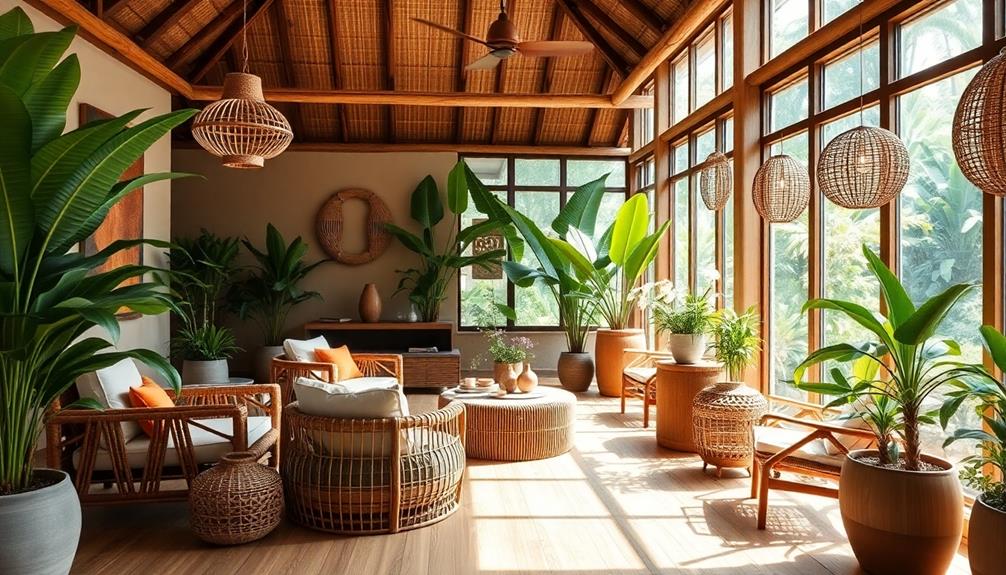
If you're looking to create stylish and sustainable Indonesian interiors, consider using eco-friendly materials like bamboo and reclaimed wood. Bamboo grows rapidly and offers versatility, making it perfect for flooring and furniture. Reclaimed wood adds character while helping reduce waste. Don't overlook natural fibers, such as jute and coconut coir, which improve indoor air quality and support local craftsmanship. Thatch roofing not only looks traditional but also provides excellent insulation. Incorporating these materials enhances aesthetics and contributes to a healthier planet. Want to discover even more sustainable options? There's plenty to explore in eco-conscious design!
Key Takeaways
- Bamboo is a rapidly renewable material, perfect for flooring and furniture, with natural anti-bacterial properties and no harmful emissions.
- Teak wood offers durability and weather resistance, making it ideal for both indoor and outdoor furniture in Indonesian interiors.
- Reclaimed wood not only reduces waste but also adds character and history to spaces, supporting sustainable design practices.
- Natural fiber materials like jute and coconut coir enhance indoor air quality and promote local craftsmanship while being biodegradable.
- Low-VOC paints and natural finishes minimize indoor air pollution, ensuring a healthier living environment in eco-friendly interiors.
Sustainable Wood Options
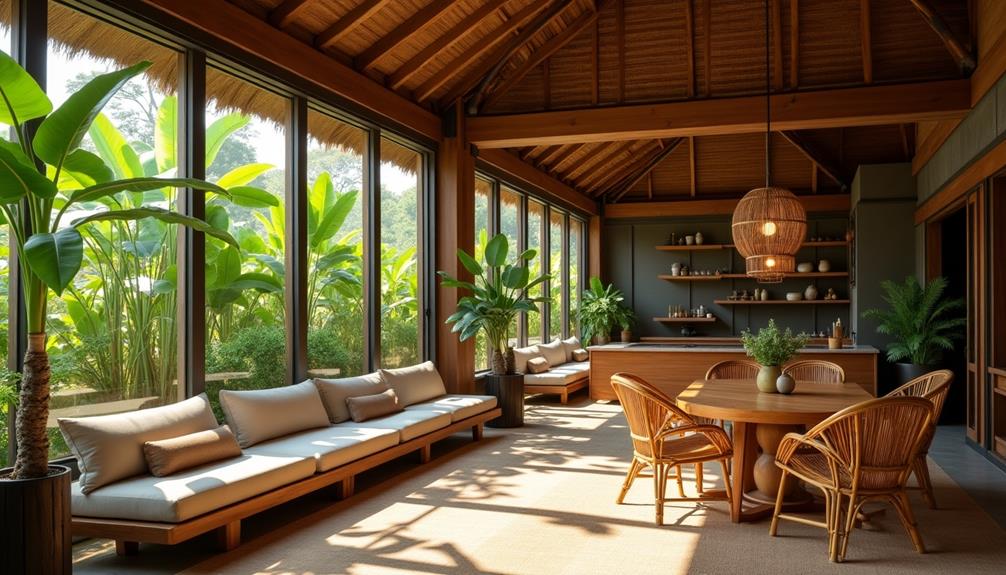
When you choose sustainable wood options for your interiors, you're not just making a design choice; you're also supporting eco-friendly practices.
Bamboo is a fantastic sustainable material, growing rapidly and serving as an excellent choice for flooring and furniture. It's both stylish and eco-conscious, embodying the principles of Balinese design characteristics which emphasize sustainability through eco-friendly materials.
Teak wood, known for its durability and resistance to weather and pests, makes for ideal indoor and outdoor furniture, ensuring longevity that cuts down on frequent replacements.
Coconut wood, harvested from aging palm trees, provides a unique aesthetic while minimizing waste, promoting sustainability in wood use.
Reclaimed wood, sourced from old structures or furniture, not only reduces waste but also injects character and history into your designs, echoing a commitment to a circular economy.
Incorporating these sustainable wood options into your interiors means you're actively participating in eco-friendly practices.
The beauty of using recycled wood is that it adds depth and uniqueness to your space, all while being kind to the environment.
Recycled Plastic Innovations
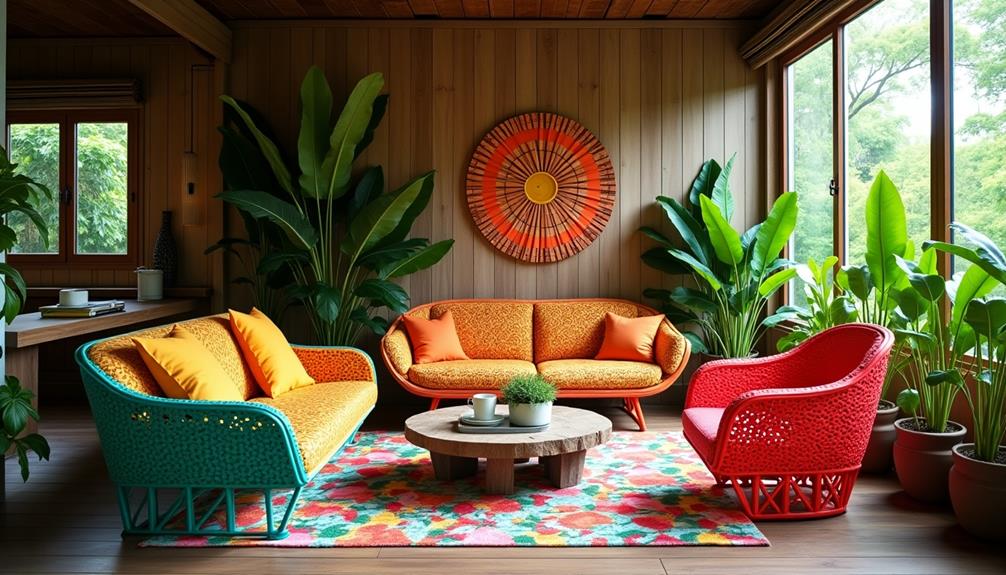
Recycled plastic innovations are transforming the way we think about waste and design. With over 300 million tons of plastic produced globally each year, companies like DuaKala are leading the charge by turning shredded plastic into stylish, sustainable furniture. This creative process not only showcases artistic designs but also promotes sustainability through innovative collaboration.
Incorporating elements like Indonesian decorative pillows into these designs can further enhance the aesthetic appeal while supporting local artisans.
When you choose recycled plastic products for your interior projects, you're actively participating in reducing the environmental impact of plastic waste. The recycling process diverts materials from landfills while decreasing the need for new plastic production, which in turn lowers carbon emissions associated with manufacturing.
These advancements in recycled plastics have resulted in durable materials ideal for furniture and decor, proving that eco-friendly solutions can be both functional and aesthetically pleasing. By incorporating recycled plastics into your designs, you contribute to a circular economy, where materials are reused and the reliance on virgin resources is minimized.
In essence, embracing recycled plastic innovations allows you to create beautiful spaces while making a positive impact on the environment. It's a win-win for both your interiors and the planet!
Natural Fiber Materials
When you consider natural fiber materials for your interiors, you're choosing sustainable options like bamboo, jute, and coconut coir.
These materials not only enhance your space but also improve indoor air quality and support local craftsmanship.
Additionally, incorporating elements like traditional artistry can bring a unique cultural touch to your decor.
Embracing natural fibers can transform your home while making an eco-friendly statement.
Sustainable Fiber Options
Sustainability in interior design is more than a trend; it's a commitment to a healthier planet. Choosing sustainable fiber options can greatly reduce environmental degradation while enhancing the beauty of your Indonesian interiors. Here are some fantastic natural fiber materials to take into account:
| Fiber | Key Features | Uses |
|---|---|---|
| Bamboo | Rapidly renewable, grows 1.5 inches/day | Flooring, furniture, decor |
| Jute | Biodegradable, low environmental impact | Rugs, curtains, upholstery |
| Rattan | Durable, flexible, promotes sustainable harvesting | Furniture, decorative items |
| Cotton | Organic, reduces pesticide use | Cushions, upholstery, drapes |
| Hemp | Strong, versatile, minimal water needed | Textiles, wall coverings |
Benefits of Natural Fibers
Choosing sustainable fiber options not only enhances the aesthetics of your interiors but also brings numerous benefits that positively impact both your living space and the environment.
By incorporating natural materials like bamboo, jute, and coconut coir, you can enjoy the following advantages: Traditional Indonesian housing often utilizes these eco-friendly materials, showcasing their importance in both culture and sustainability.
Traditional Indonesian housing reflects the rich architectural heritage of the region through the use of local resources.
- Renewability: Bamboo grows up to 1.5 inches per day, making it a highly renewable resource for your sustainable interior.
- Indoor Air Quality: Natural fibers are biodegradable and don't emit volatile organic compounds (VOCs), improving your home's air quality.
- Hypoallergenic Properties: Textiles like cotton and hemp are hypoallergenic, reducing allergy risks and creating a healthier living environment.
- Thermal Insulation: Materials like thatch and coconut coir help regulate indoor temperatures, enhancing comfort year-round.
Eco-Friendly Finishes
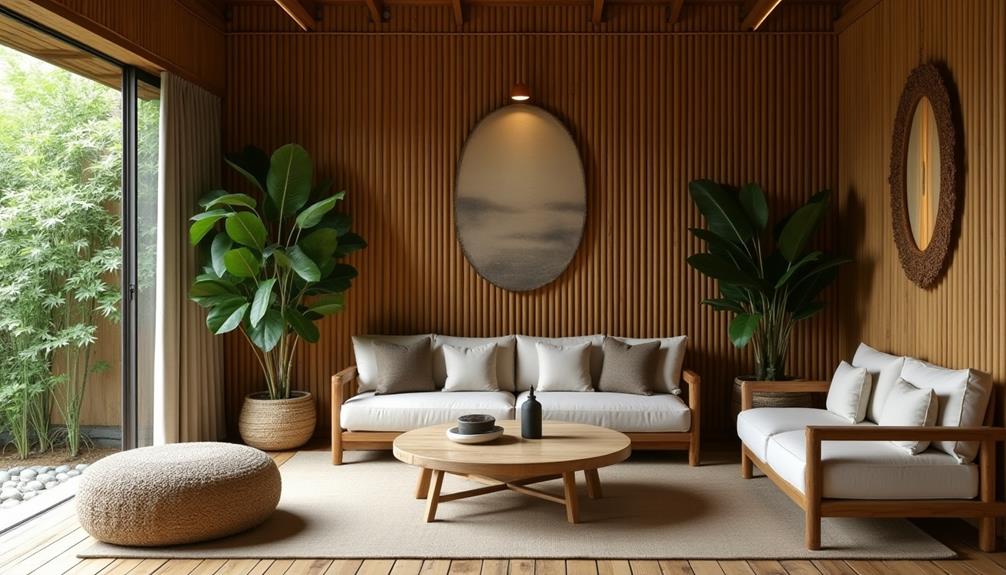
Transforming your interiors with eco-friendly finishes not only enhances their beauty but also supports a healthier living environment.
Consider using sustainable materials like natural oils and waxes, such as tung oil and beeswax, to bring out the wood's innate charm while providing a non-toxic protective layer. These finishes are perfect for creating a warm and inviting atmosphere and can complement stunning decor items like Indonesian decor masks that celebrate rich cultural heritage.
Low-VOC paints and finishes are also gaining traction in Indonesia, as they greatly reduce indoor air pollution and improve air quality.
If you're looking for a unique touch, reclaimed wood finishes add character and history to your space while minimizing the demand for new timber resources.
Another great option is water-based finishes, which are preferred for their lower environmental impact and reduced harmful chemicals compared to traditional solvent-based options.
For coloring, opt for natural stains derived from plant materials like coffee or tea, offering rich hues without the environmental harm associated with synthetic dyes.
Biodegradable Design Elements
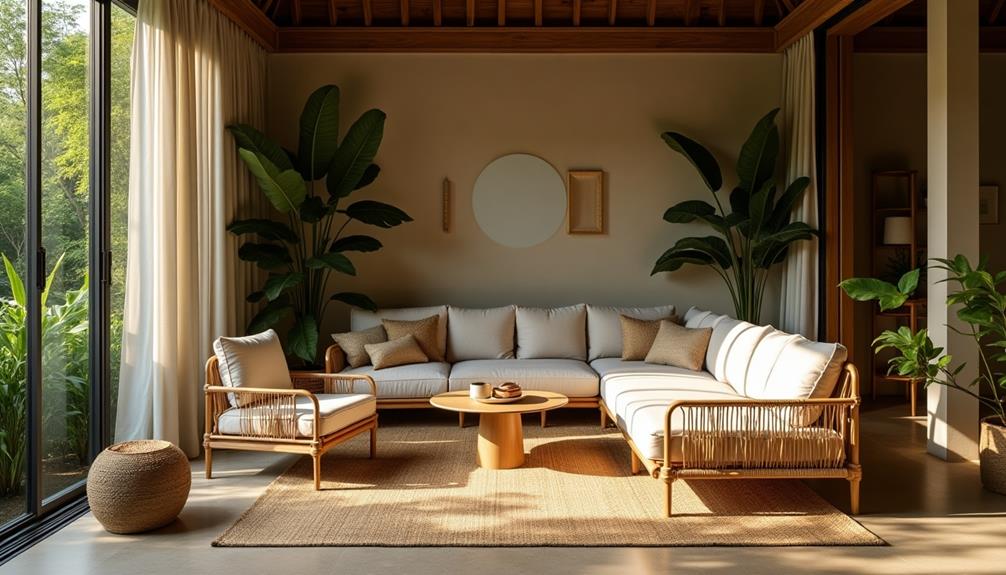
When you choose biodegradable design elements, you're opting for natural materials that not only look great but also support sustainability.
Incorporating options like bamboo and coconut wood adds a unique aesthetic appeal while being eco-friendly, as seen in traditional Indonesian style home decor.
These choices not only enhance your space but also contribute to a healthier environment.
Natural Material Options
Natural materials are a fantastic choice for creating eco-friendly interiors that embrace sustainability without sacrificing style.
By opting for biodegradable design elements, you can enhance your space while making a positive environmental impact. Incorporating elements from luxury tropical design aesthetics can elevate your interior while maintaining eco-friendliness.
Here are some excellent options to contemplate:
- Bamboo: This rapidly growing plant can be used for flooring, furniture, and decor, making it a standout choice for sustainable design.
- Coconut Wood: Utilizing waste from aging coconut palms, coconut wood adds a unique touch to your interiors while being strong and durable.
- Thatch Roofing: Crafted from natural materials like straw and palm leaves, thatch roofing provides excellent insulation and a traditional aesthetic, all while being biodegradable.
- Reclaimed Timber: Giving new life to deconstructed buildings, reclaimed timber not only adds character but also keeps waste out of landfills.
Incorporating these natural materials into your home can create a warm, inviting atmosphere while supporting a sustainable lifestyle.
Embrace biodegradable design elements, and you'll transform your space into an eco-friendly haven that reflects your commitment to the environment.
Sustainable Aesthetic Appeal
Embracing biodegradable design elements not only enhances the aesthetic appeal of your interiors but also supports a sustainable lifestyle. By incorporating materials like bamboo and coconut wood, you can achieve a beautiful, organic look while minimizing environmental impact.
These options exemplify sustainable practices that reduce waste and promote eco-friendliness. Additionally, the use of natural materials like wood and stone in your interior spaces reflects the principles of modern tropical aesthetics in Bali, creating a harmonious connection with the environment.
Thatch roofing made from straw and palm leaves adds an inviting texture to your space, serving as both an insulator and a stylish design choice. Similarly, reclaimed wood introduces a rustic charm while keeping materials out of landfills, making it a win-win for your aesthetic and the planet.
Biophilic design principles further elevate your interiors by integrating natural elements that enhance mental well-being and productivity. When you choose decorative elements made from recycled materials, such as repurposed plastics and metals, you create striking visuals while tackling the global plastic waste crisis.
Incorporating these biodegradable design elements not only enriches your home's aesthetic but also reflects your commitment to sustainability, creating spaces that are beautiful, functional, and environmentally responsible.
Upcycled and Repurposed Items
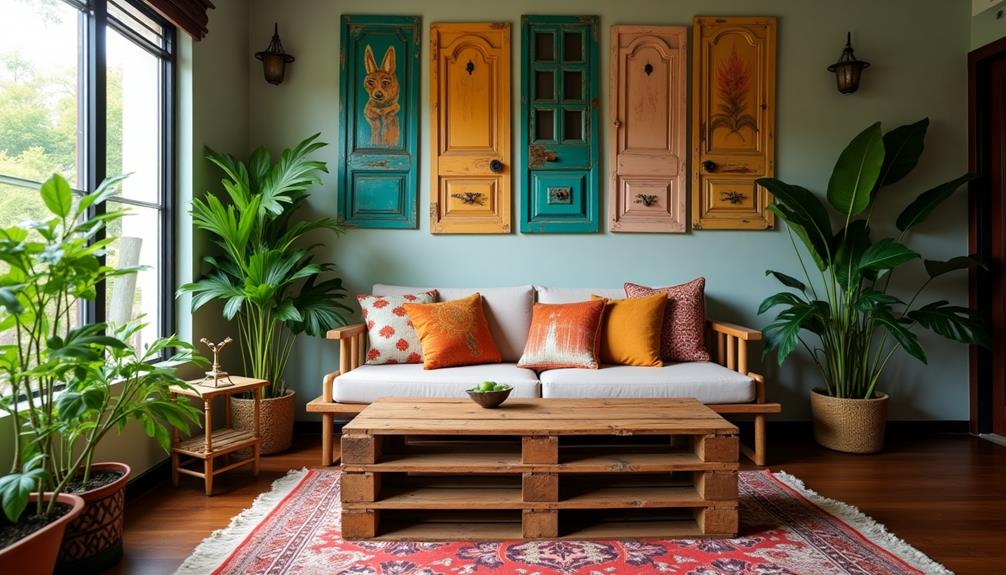
Upcycled and repurposed items are revolutionizing Indonesian interiors, turning waste into stunning decor and functional furniture. These innovative designs greatly reduce waste while promoting a sustainable lifestyle.
By incorporating upcycled materials, you not only enhance your space but also contribute to a healthier planet. Additionally, the creativity in using these materials reflects the same ethos seen in luxury tropical designs that blend modern aesthetics with nature.
Here are some inspiring examples of upcycled and repurposed items:
- Reclaimed wood: Companies like I-Rewood transform timber from demolished structures, minimizing deforestation.
- Old tires: ArtCycleBALI creatively converts discarded tires and inner tubes into fashionable accessories, raising awareness about recycling.
- Shredded plastic: DuaKala addresses plastic waste by crafting innovative designs, showcasing artistic collaborations in sustainable products.
- Coconut wood and bamboo: These materials not only add unique aesthetics but also eliminate harmful chemicals common in traditional furniture.
Bamboo as a Resource
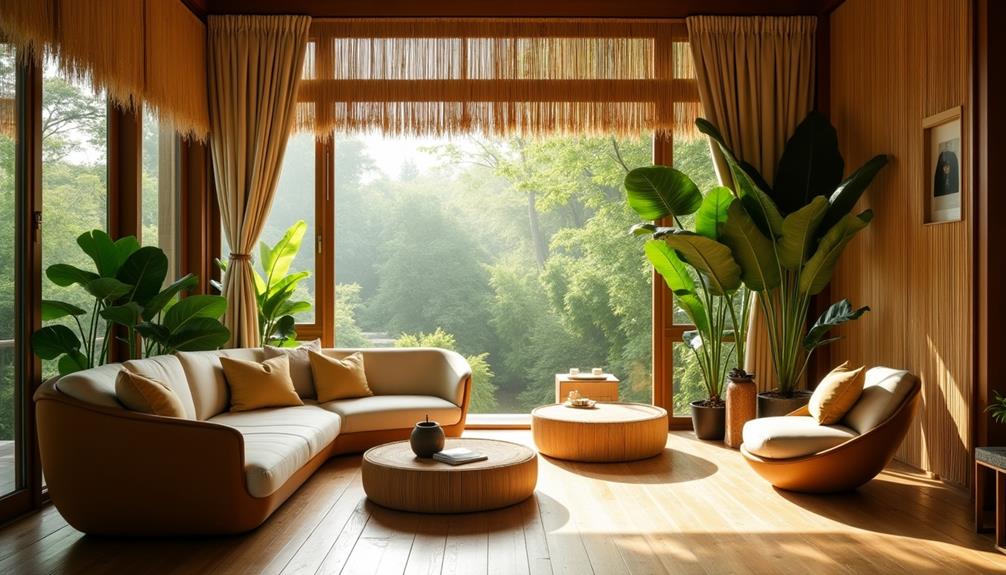
As you explore innovative ways to enhance your interiors, bamboo stands out as a remarkable resource. This fast-growing plant can reach up to 1.5 inches a day, making it an incredibly renewable option for your interior design projects. Its strength and durability often rival that of hardwood, allowing for effective use in flooring, furniture, and structural supports.
Beyond its physical attributes, bamboo also boasts natural anti-bacterial properties and doesn't emit volatile organic compounds (VOCs), contributing to better indoor air quality. Plus, its versatility means you can find bamboo in various forms—laminated panels, woven textiles, or solid planks—suiting different design aesthetics.
Here's a quick comparison of bamboo's benefits:
| Feature | Bamboo |
|---|---|
| Growth Rate | Up to 1.5 inches per day |
| Strength | Comparable to hardwood |
| Environmental Impact | Reduces reliance on timber sources |
Incorporating bamboo into your interior design not only elevates your space but also promotes sustainable living by combating deforestation and environmental degradation.
The Role of Thatch Roofing
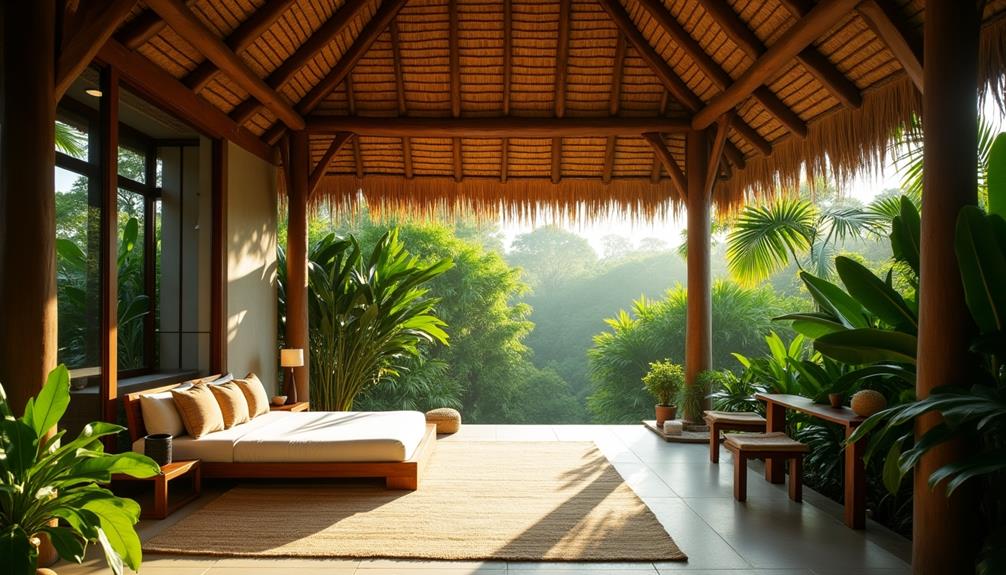
While many modern roofing materials prioritize functionality, thatch roofing offers a unique blend of natural beauty and sustainability. This traditional roofing method, made from straw, reeds, and palm leaves, isn't just aesthetically pleasing but also environmentally friendly.
By choosing thatch, you're embracing a design that enhances your home while being kind to the planet. Additionally, incorporating traditional Indonesian wedding decor can further enhance your home's aesthetic, creating a harmonious blend of indoor and outdoor spaces that celebrate local culture.
Here are some key benefits of thatch roofing:
- Biodegradable: Since it consists of natural materials, it decomposes easily, leaving no harmful waste.
- Energy Efficient: Thatch provides excellent insulation, helping to keep your home cool in Indonesia's tropical climate, reducing energy consumption.
- Sustainable Sourcing: Local availability of materials means thatch roofing supports sustainable building practices with minimal processing.
- Biodiversity Support: It creates habitats for various organisms, promoting ecological balance in your environment.
Frequently Asked Questions
What Are Environmentally Friendly Products for Interior Design?
When choosing environmentally friendly products for interior design, consider sustainable materials like bamboo, recycled wood, and natural fibers. These options not only reduce your carbon footprint but also create a unique and beautiful living space.
What Material Is More Eco Friendly?
Imagine planting bamboo; it flourishes quickly, like your eco-friendly choices. When you ask what material's more eco-friendly, consider bamboo's rapid growth and carbon absorption, making it a top contender for sustainable living and design.
How Can We Be Eco Friendly in Bali?
You can be eco-friendly in Bali by choosing locally sourced materials, like bamboo and coconut wood. Support local artisans, use reclaimed wood for furniture, and select low-VOC finishes for a healthier, sustainable living environment.
Does Ikea Use Eco Friendly Materials?
Yes, Ikea uses eco-friendly materials. They're committed to using renewable or recycled materials by 2030, currently sourcing about 60% from sustainable sources. Their initiatives focus on reducing waste and promoting sustainability in their products.
Conclusion
By choosing eco-friendly materials for your Indonesian interiors, you're not just enhancing your space; you're also making a positive impact on the environment. Did you know that using bamboo can reduce carbon emissions by up to 35% compared to traditional hardwoods? Embracing sustainable practices, like incorporating natural fibers and recycled innovations, allows you to create a beautiful, stylish home while supporting a healthier planet. Every small choice contributes to a larger change for future generations.
Home Decor & Design
Eco-Friendly Materials for Sustainable Indonesian Interiors
Transform your space with eco-friendly materials for sustainable Indonesian interiors that tell a story of culture and nature; discover how to start this journey.
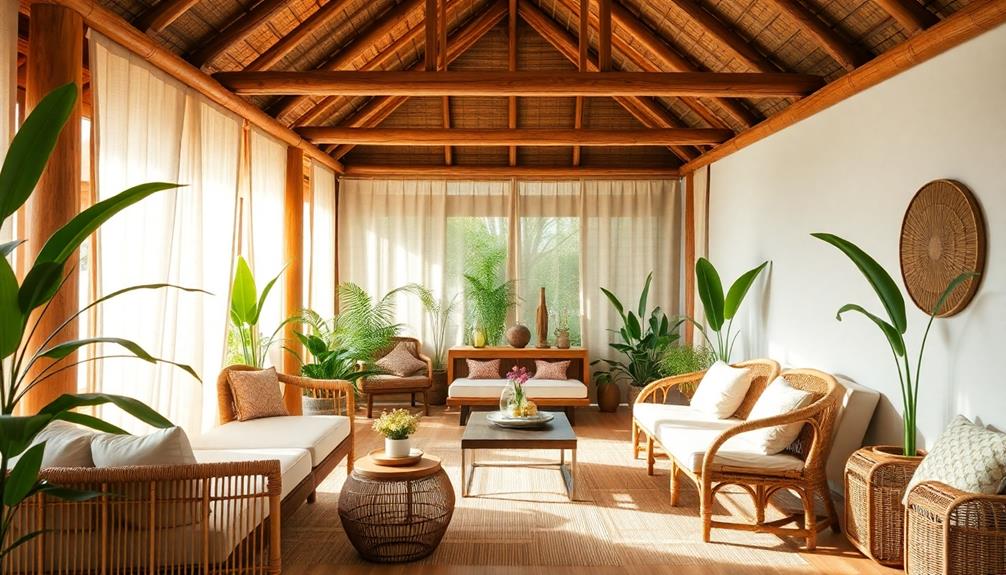
If you're looking to create a sustainable Indonesian interior, eco-friendly materials are key. You can use bamboo, which grows rapidly, and provides good strength while improving air quality. Teak wood offers durability and resists moisture, ensuring longevity in your furnishings. Consider coconut wood too; it reduces waste and adds a unique aesthetic to your space. Incorporating reclaimed wood not only minimizes deforestation but also adds character through its history. Supporting local artisans through these materials connects you to Indonesia's rich culture. For more insights into sustainable practices, you'll find lots of inspiring ideas ahead.
Key Takeaways
- Eco-friendly materials like bamboo, teak, and coconut wood support sustainability by reducing deforestation and promoting local ecosystems in Indonesian interiors.
- Bamboo is a rapidly renewable resource with high tensile strength, making it ideal for both structural and decorative applications.
- Teak wood's durability and natural moisture resistance enhance outdoor furniture longevity while promoting responsible forestry practices.
- Reclaimed wood and recycled materials minimize waste and energy consumption, adding unique character to interiors and improving air quality.
- Local sourcing of materials supports community livelihoods and preserves cultural heritage through traditional craftsmanship in sustainable design.
Importance of Eco-Friendly Materials
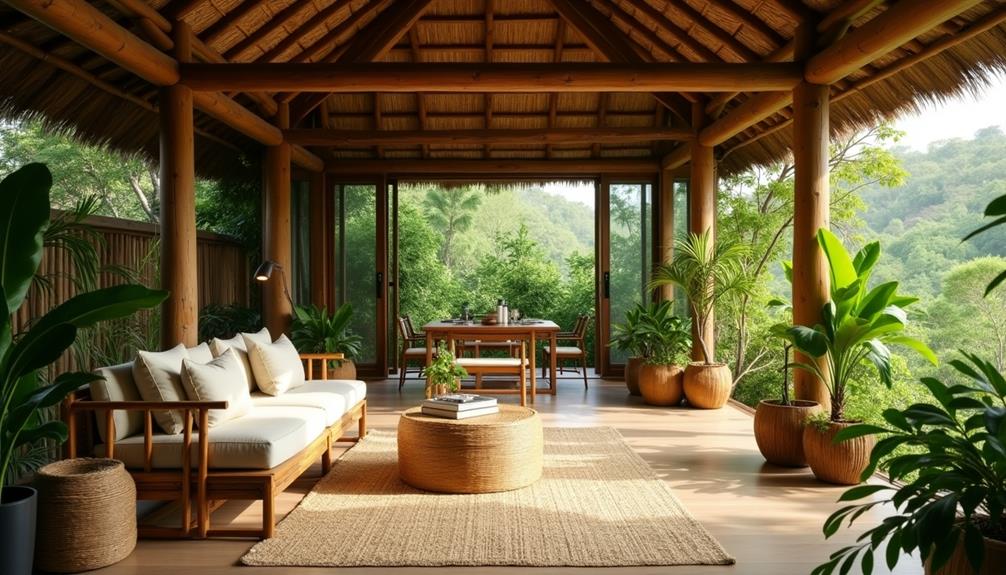
Recognizing the importance of eco-friendly materials is fundamental for anyone looking to create sustainable interiors. By choosing sustainable materials like sustainably sourced teak and bamboo, you can greatly reduce your environmental impact while promoting biodiversity. These materials help minimize deforestation and habitat destruction in regions like Indonesia, which is essential for maintaining ecological balance.
Additionally, using natural materials in design enhances the aesthetic appeal and aligns with traditional Balinese principles.
Using materials such as coconut wood, a byproduct of aging palms, not only aids in waste reduction but also adds a unique aesthetic to your designs. Furthermore, incorporating thatch roofing made from natural materials like straw and palm leaves enhances insulation and biodegradability, contributing to energy efficiency in your spaces.
Opting for certified materials, like those sourced from the Forest Stewardship Council (FSC), guarantees that you support responsible harvesting practices. This not only benefits local communities but also helps protect ecosystems.
In addition, implementing eco-friendly materials aligns with the growing consumer demand for sustainable products, enhancing your brand reputation and attracting environmentally conscious clients. By prioritizing these materials in your design process, you play an essential role in fostering a more sustainable future while creating beautiful, functional spaces.
Overview of Sustainable Materials
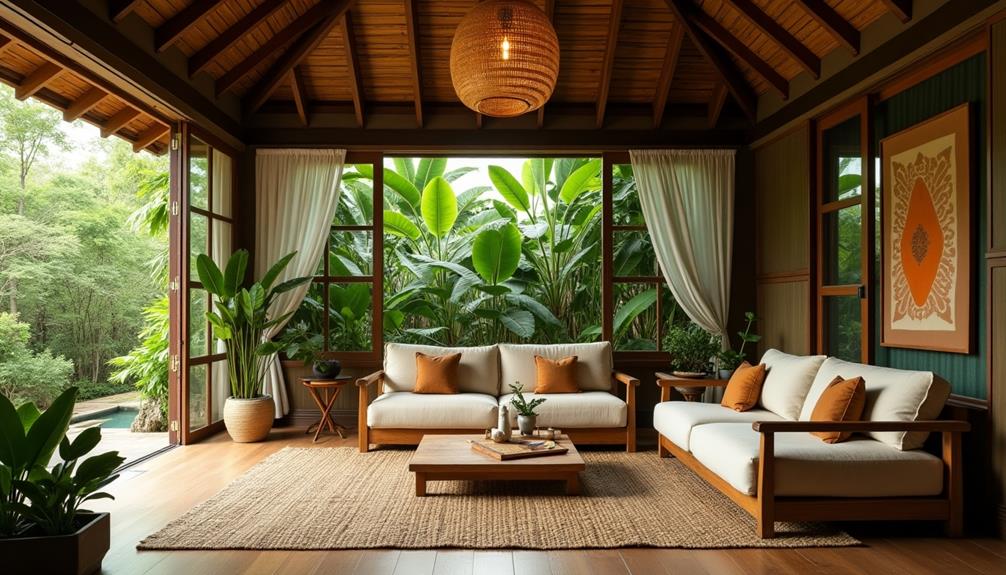
When you're looking to create a sustainable interior, consider the benefits of bamboo, teak wood, and coconut wood.
Bamboo grows rapidly and offers a renewable option, making it an excellent choice for Indonesian decorative pillows that enhance living spaces.
Meanwhile, teak's strength guarantees durability in your furniture, perfect for long-lasting applications.
Coconut wood not only reduces waste but also adds a unique aesthetic to your space.
Bamboo's Renewable Benefits
Embracing bamboo as a sustainable material brings a wealth of renewable benefits that can transform Indonesian interiors. This remarkable plant grows at an impressive rate of 1.5 inches per day, making it an incredibly renewable resource for eco-friendly building. Bamboo not only absorbs carbon dioxide efficiently but also releases oxygen, improving air quality and reducing your carbon footprint.
Here's a quick comparison of bamboo and traditional hardwood:
| Feature | Bamboo |
|---|---|
| Growth Rate | 1.5 inches per day |
| Carbon Absorption | Higher than most trees |
| Strength | Greater tensile strength than steel |
| Chemical Usage | Minimal pesticides needed |
Bamboo's natural strength and flexibility make it a strong alternative to hardwoods, suitable for various structural applications. Plus, its cultivation requires fewer chemicals, promoting healthier ecosystems. By incorporating bamboo into your interiors, you can not only create stunning designs but also support sustainable materials that benefit both the environment and your living space. So, consider bamboo for your next eco-friendly building project!
Teak Wood Durability
Choosing teak wood for your interiors means investing in durability and sustainability. Teak is renowned for its exceptional strength, making it a top choice for both indoor and outdoor sustainable furniture.
Its natural oils provide inherent protection against moisture, ensuring it withstands humid environments like Indonesia without losing structural integrity. This aligns beautifully with the craftsmanship seen in Indonesian decor masks, which celebrate the rich cultural heritage and traditional artistry of the region.
Unlike other woods, teak's stability means it's less prone to warping or cracking, which enhances its longevity.
Sustainably sourced teak wood is often harvested from managed plantations, promoting responsible forestry practices that combat environmental degradation. This approach not only reduces deforestation but also supports the ecosystem.
With a lifespan exceeding 50 years, teak wood proves to be a cost-effective investment, minimizing the need for frequent replacements that can burden the environment.
Coconut Wood Aesthetics
Coconut wood brings a unique charm to Indonesian interiors, transforming spaces with its distinctive grain patterns and rich color variations. This sustainable material is derived from aging coconut palms, which would otherwise be discarded after their fruit-bearing years, helping to reduce waste in the furniture industry.
Additionally, incorporating coconut wood aligns with the ethos of luxury tropical designs that embrace natural materials and vibrant aesthetics. Each piece of coconut wood furniture showcases a unique aesthetic, making it visually appealing and perfect for adding character to your home.
Not only does coconut wood look great, but it also offers durability; it's naturally resistant to pests and decay, making it suitable for both indoor and outdoor applications. By choosing coconut wood, you're selecting eco-friendly, environmental materials that align with sustainable design principles.
Moreover, using coconut wood supports local economies in Indonesia by promoting fair trade and providing income to coconut farmers. This sustainable product contributes to a lower carbon footprint, further enhancing its appeal for environmentally-conscious consumers.
Traditional Materials in Indonesian Design
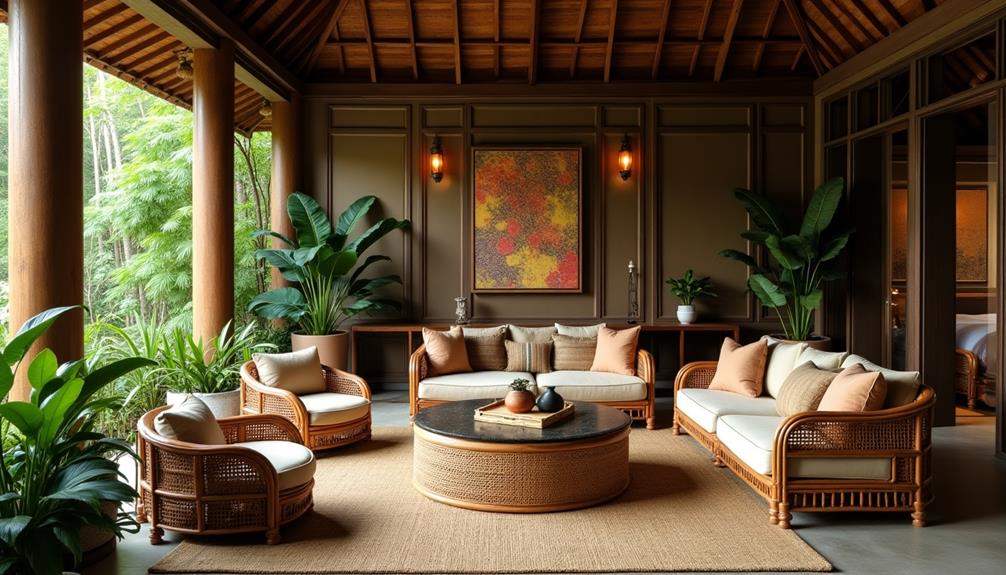
Throughout Indonesia's rich cultural heritage, traditional design showcases an impressive array of locally sourced materials that highlight the region's unique architectural identity.
These materials not only exemplify sustainable practices but also reflect the diverse architectural styles influenced by traditional Indonesian houses. When you explore these traditional materials, you'll discover their sustainable qualities and the beauty they bring to interiors.
Here are four key materials that exemplify this approach:
- Bamboo: This fast-growing plant can reach 1.5 inches daily, making it a highly renewable resource with versatile applications in both structural supports and decorative elements.
- Teak Wood: Renowned for its weather resistance and durability, teak is often used in outdoor furniture, embodying the craftsmanship of Indonesian artisans.
- Coconut Wood: As a byproduct of aging coconut palms, this material not only reduces waste but also offers a unique aesthetic for furniture and flooring.
- Thatch Roofing: Made from natural materials like straw and palm leaves, thatch roofs provide excellent insulation and biodegradability, reflecting traditional Indonesian architectural practices.
These sustainable materials not only enhance the beauty of your space but also connect you to the rich traditions of Indonesian design.
Embracing them means celebrating both culture and sustainability.
Innovative Eco-Friendly Alternatives
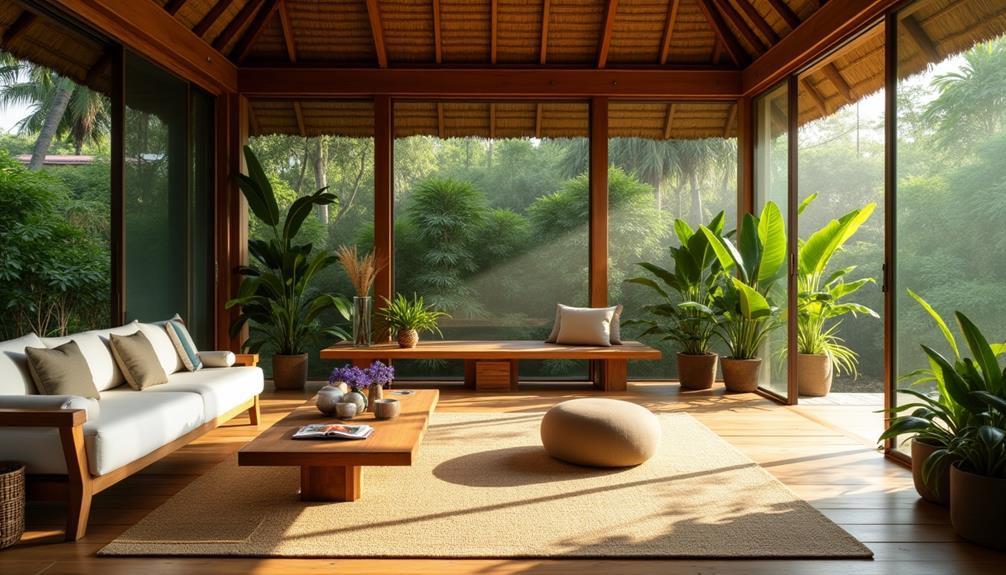
When you think about innovative eco-friendly alternatives, bamboo stands out as a remarkable building material due to its rapid growth and strength.
Its use aligns with the growing trend of sustainable designs in modern Indonesian housing that emphasize eco-friendly practices.
Additionally, using reclaimed wood not only helps reduce waste but also brings unique character to your interior spaces.
Bamboo as Building Material
Many builders and designers are discovering the incredible potential of bamboo as a building material. This fast-growing plant offers several advantages that make it a top choice for sustainable materials, particularly in Tropical Villa Plans where natural elements are emphasized.
Here are four key benefits of using bamboo in construction:
- Rapid Growth: Bamboo can grow up to 1.5 inches per day, making it a highly renewable resource.
- High Strength: Its tensile strength rivals that of steel, providing excellent support for structures and flooring.
- Natural Insulation: Bamboo's properties help regulate indoor temperatures, which can greatly reduce energy consumption.
- Environmental Benefits: Bamboo absorbs carbon dioxide and releases oxygen, enhancing air quality and minimizing environmental impact.
Reclaimed Wood Utilization
In recent years, reclaimed wood has emerged as a popular choice for eco-friendly interior design in Indonesia. Sourced from deconstructed buildings and old furniture, this material reduces the need for new lumber, markedly minimizing deforestation impacts in the country's furniture industry.
By opting for reclaimed wood, you're not only diverting waste from landfills but also adding unique character to your space, thanks to its historical patina and varied textures. Additionally, incorporating traditional artistry through unique decorative pieces, such as Indonesian decor masks, can enhance the cultural richness of your interiors.
The process of reclaiming wood typically requires less energy and results in fewer greenhouse gas emissions compared to traditional logging and processing methods. Many reclaimed wood products come with certifications, ensuring they align with sustainable practices that protect biodiversity in Indonesia.
This way, you can make a statement about your commitment to the environment.
Incorporating reclaimed wood into your interior design not only enhances the aesthetic appeal but also boosts your sustainability credentials. This approach attracts environmentally conscious consumers who value responsible sourcing.
Benefits of Using Recycled Materials
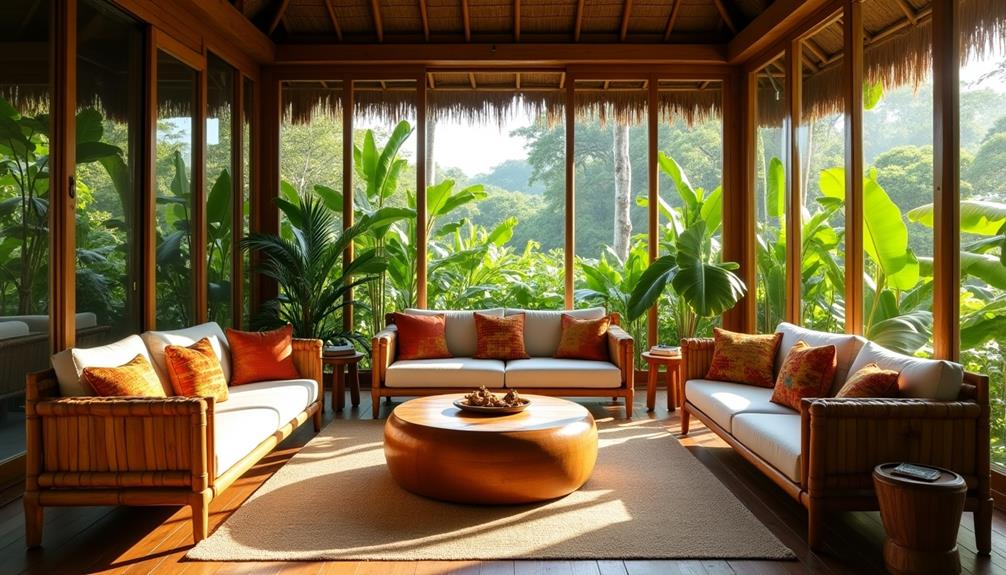
Using recycled materials in your interior design not only helps the environment but also offers a range of practical benefits.
When you choose recycled materials, you're making a more sustainable design choice that impacts both your space and the planet. Incorporating these materials aligns with the principles of traditional Indonesian home decor, which emphasizes harmony with nature and the use of natural resources.
Here are four key advantages:
- Waste Reduction: By using recycled materials, you can greatly reduce waste, diverting millions of tons from landfills each year.
- Cost Efficiency: Incorporating these materials often lowers production costs, allowing you to pass savings onto consumers.
- Aesthetic Appeal: Recycled materials, like reclaimed wood and recycled plastics, add unique character and history to your interiors, making them truly one-of-a-kind.
- Improved Air Quality: Many recycled options don't emit volatile organic compounds (VOCs), leading to better indoor air quality in your home or office.
Local Sourcing and Community Impact
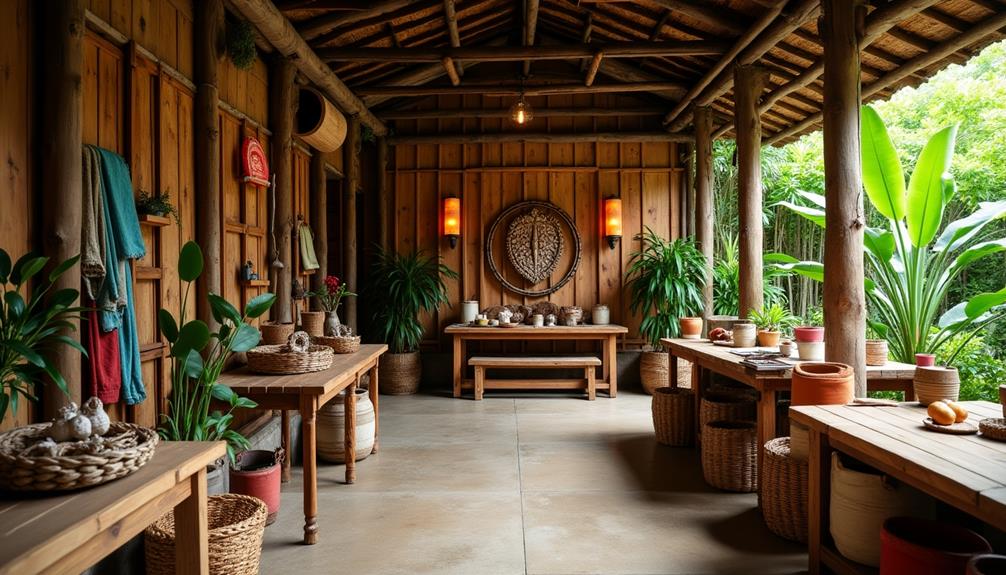
Sourcing materials locally not only supports sustainable practices but also fosters vibrant communities in Indonesia. When you choose local sourcing, like bamboo and teak, you help reduce transportation emissions, cutting down the overall carbon footprint of furniture production.
This approach preserves local ecosystems and promotes biodiversity, effectively combating environmental degradation caused by deforestation. Incorporating elements such as traditional motifs and patterns can additionally enhance cultural significance in sustainable decor, bringing a sense of heritage to modern designs. The use of eco-friendly materials aligns with the values of celebrations like Indonesian Wedding Decor, showcasing the beauty of local craftsmanship.
The community impact of local sourcing is profound. By employing local artisans and craftsmen in the production process, you provide livelihoods that support traditional skills in furniture making. This connection to heritage enriches the community while ensuring that valuable skills aren't lost to time.
Certifications like SVLK (Sistem Verifikasi Legalitas Kayu) guarantee that the wood used is sourced legally, promoting responsible harvesting practices that protect local forests.
In addition, engaging in corporate social responsibility initiatives allows furniture companies to reinvest in local communities, fostering awareness and education about sustainable living practices among residents.
Case Studies of Sustainable Interiors
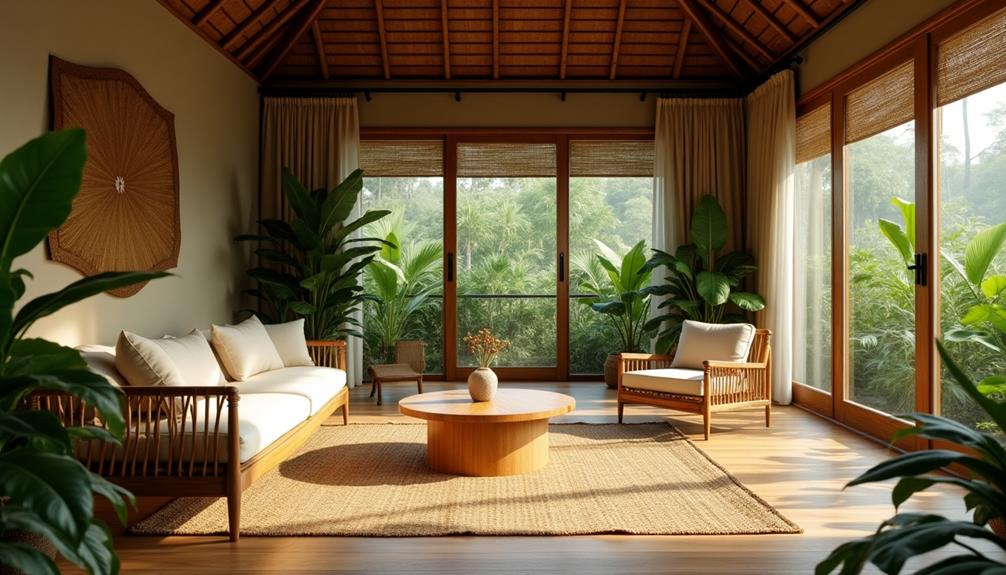
Local sourcing not only supports sustainable practices but also inspires innovative design. In Indonesia, several case studies showcase how sustainable architecture can effectively utilize natural materials while promoting eco-friendliness.
Here are four standout examples:
- Fivelements Retreat Bali: This wellness-focused retreat integrates locally sourced materials, creating a serene environment that embodies natural aesthetics.
- Bambu Indah Resort: With its stunning bamboo architecture, this resort not only highlights sustainable building practices but also celebrates local craftsmanship and culture.
- Ulaman Eco Retreat: This project exemplifies luxury living in harmony with nature, employing eco-friendly materials and techniques to create beautiful spaces that respect the environment.
- Coconut Wood Furniture: By using coconut wood, a byproduct of aging palms, various interior projects reduce waste while offering a unique, durable aesthetic.
These examples demonstrate how sustainable interiors can harmonize with the environment and local communities.
Future Trends in Sustainable Design

Sustainable design is rapidly evolving to meet the demands of a changing world, and you'll find that future trends are set to transform how we approach interiors. As climate change becomes a pressing issue, designers are prioritizing resilience in their projects, ensuring buildings withstand extreme weather while remaining functional and sustainable.
The integration of biophilic design principles is also gaining momentum, as it enhances occupant well-being by incorporating natural elements and improving indoor air quality. Additionally, advanced technologies like smart energy management systems are becoming essential, reducing environmental impact through greater efficiency.
Cultural heritage preservation is another trend, focusing on the adaptive reuse of existing structures, which minimizes waste and celebrates local history. Finally, sustainable urban planning emphasizes the importance of green spaces and efficient public transport, fostering an environmentally friendly atmosphere that improves urban life.
| Trend | Description |
|---|---|
| Biophilic Design | Incorporates natural elements for well-being |
| Climate Resilience | Focus on buildings that withstand extreme weather |
| Smart Technologies | Energy management systems for efficiency |
| Cultural Preservation | Reusing structures to minimize waste |
Frequently Asked Questions
What Are the Sustainable Materials Which Are Responsible for the Eco Friendly Design?
When considering sustainable materials for eco-friendly design, think about bamboo, teak wood, coconut wood, thatch roofing, and rattan veneer. Each offers unique benefits, promoting sustainability while enhancing aesthetics in your projects.
What Material Is More Eco Friendly?
When you sift through nature's treasure trove, bamboo often shines brightest. Its rapid growth and carbon-sequestering prowess make it an eco-friendly champion. Yet, teak and coconut wood also weave sustainability into their beautiful fabric.
Does Ikea Use Eco Friendly Materials?
Yes, Ikea uses eco-friendly materials. They're committed to sustainable sourcing, utilizing recycled plastics, bamboo, and water-based finishes. You'll find their products designed to minimize environmental impact while promoting a healthier indoor space for you.
What Is an Eco Friendly Accessory Interior Design?
You might not realize it, but eco-friendly accessories in interior design, like reclaimed wood decor or organic textiles, can transform your space while reducing environmental impact and promoting healthier indoor air quality. It's a win-win!
Conclusion
So, while you might think that decorating sustainably means sacrificing style, you're actually just a step away from transforming your space into a vibrant masterpiece. Embracing eco-friendly materials doesn't mean you're living in a bamboo hut—far from it! Instead, you're blending tradition with innovation, creating a unique interior that tells a story. In the end, going green could just be the new black, making your home not only stylish but a true reflection of your values.
Home Decor & Design
10 Sustainable Materials for Indonesian Interiors
Navigate the world of sustainable materials for Indonesian interiors and discover how nature can transform your space in unexpected ways.
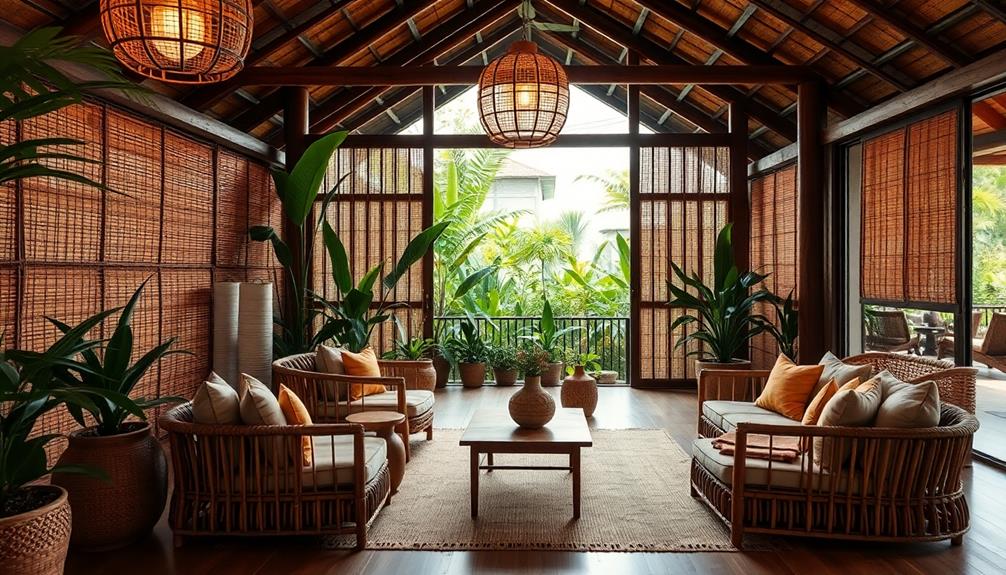
You can transform your Indonesian interiors by using sustainable materials like bamboo, known for its rapid growth and durability. Teak wood offers a beautiful finish while resisting moisture and pests. Coconut wood, a byproduct of palm harvesting, adds rich tones and supports local economies. Reclaimed wood brings unique character and reduces waste. For roofing, consider thatch, which improves insulation and reflects traditional aesthetics. Natural fiber textiles like jute and hemp enhance your decor while being eco-friendly. Finally, rammed earth and locally sourced stone provide natural beauty and low energy costs. Stay tuned to discover even more options for your space!
Key Takeaways
- Bamboo's rapid growth and natural pest resistance make it an eco-friendly choice for structural supports and flooring in Indonesian interiors.
- Teak wood offers durability, weather resistance, and aesthetic appeal, making it ideal for furniture and decorative elements while supporting sustainable harvesting practices.
- Coconut wood, a byproduct of aging palms, enhances interiors with rich tones while promoting a circular economy and reducing waste.
- Natural fibers like jute and organic cotton provide biodegradable options for textiles, supporting sustainable practices and eco-conscious consumer preferences.
- Recycled plastic materials can be creatively used in furniture and flooring, reducing landfill waste while mimicking traditional designs and enhancing durability.
Bamboo
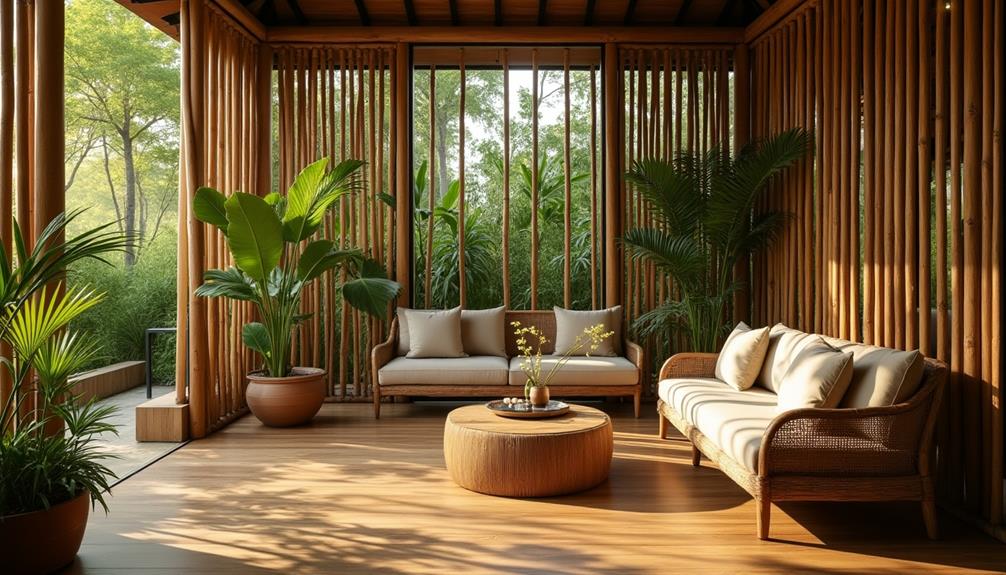
As you explore sustainable materials for your Indonesian interiors, bamboo stands out due to its remarkable growth rate and renewability. It's one of the fastest-growing plants globally, able to grow up to 1.5 inches per hour. This makes bamboo an excellent choice for those seeking sustainable materials, as it can be harvested without depleting natural resources.
Additionally, bamboo's natural aesthetic complements the emphasis on natural materials found in Balinese interior design, enhancing the overall harmony of your space.
Bamboo boasts a high strength-to-weight ratio, making it ideal for structural supports, flooring, and decorative elements in your interior design. Its natural pest resistance means it requires minimal chemical treatments, enhancing indoor air quality compared to traditional materials.
By choosing bamboo, you're not just making an eco-friendly decision; you're also supporting the local economy. Bamboo cultivation and processing provide jobs for many in Indonesia, fostering community growth.
Another benefit is bamboo's versatility in design. Whether you prefer a traditional or contemporary aesthetic, bamboo can seamlessly fit your vision for eco-friendly interiors.
With its unique qualities and sustainable nature, incorporating bamboo into your spaces allows you to create beautiful, healthy, and responsible environments.
Teak Wood
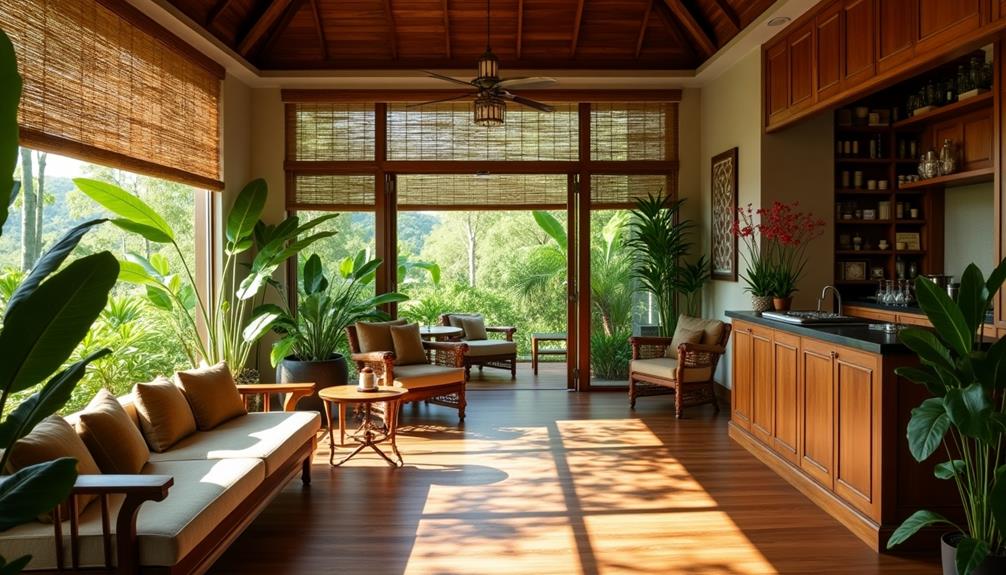
When you think about teak wood, durability and weather resistance come to mind, making it a top choice for your outdoor furniture and interior designs.
Its sustainable harvesting practices guarantee that you can enjoy its beauty while supporting responsible forestry.
Additionally, teak wood is often featured in luxury tropical designs, enhancing the overall aesthetic of your living spaces.
Plus, the aesthetic appeal and versatility of teak add a touch of elegance to any space you create.
Durability and Weather Resistance
Teak wood stands out for its remarkable durability and weather resistance, making it a top choice for both indoor and outdoor furniture in Indonesia's humid climate. Its exceptional durability comes from a natural oil content that protects against water, decay, and pests, which aligns with traditional Indonesian housing practices that prioritize sustainable materials.
This means you can confidently use teak in various settings, knowing it'll withstand the elements, as seen in traditional Indonesian housing.
With a density ranging from 600 to 700 kg/m³, teak wood offers impressive strength and resilience against wear and tear. You won't have to worry about your furniture losing its structural integrity over time.
Teak's ability to endure extreme temperatures and moisture guarantees it won't warp or crack, maintaining its aesthetic appeal.
When properly maintained, your teak furniture can last for decades, often outlasting other wood types. This durability reduces the need for replacements, promoting sustainable consumption.
Plus, the rich golden-brown hue and fine grain of teak not only enhance your interiors but also make it a desirable choice for eco-conscious consumers.
Sustainable Harvesting Practices
Sourcing teak wood responsibly is just as important as its durability and weather resistance. By choosing teak from sustainably managed plantations, you guarantee that your materials not only last but also support the environment.
Traditional and modern Indonesian housing often utilizes local materials, emphasizing the need for sustainable practices. Sustainable harvesting practices play an essential role in maintaining the health of forests and ecosystems.
Here are some key aspects of sustainable practices in teak sourcing:
- Selective Logging: This method allows trees to be harvested without damaging the surrounding ecosystem, promoting biodiversity.
- Replanting Initiatives: After harvesting, new trees are planted, making certain the forest continues to thrive for future generations.
- Regulatory Compliance: Indonesia's regulations combat illegal logging, which helps maintain responsible forestry and supports the country's economy.
Moreover, teak's natural oils make it resistant to pests and decay, minimizing the need for chemical treatments. This aligns perfectly with sustainable interior design principles.
You can also consider using reclaimed teak wood from old buildings and furniture, which reduces waste and lessens the demand for newly harvested timber. By making informed choices, you contribute to a more sustainable future while enjoying the beauty and quality of teak wood.
Aesthetic Appeal and Versatility
The natural beauty of teak wood captivates with its rich golden-brown color and fine grain, making it a top choice for upscale interior furnishings and decor. Its aesthetic appeal is undeniable, blending seamlessly into both modern and traditional settings.
Whether you're considering furniture, cabinetry, flooring, or decorative elements, teak wood's versatility allows it to shine in various applications. Additionally, incorporating teak wood into your space can complement Indonesian decorative pillows, enhancing the cultural richness of your interior design.
Teak's durability is exceptional; it resists water, pests, and decay, maintaining its beauty for decades, even in humid climates. With a Janka hardness rating of 1,155, it's one of the hardest woods, ensuring strength and resilience in high-traffic areas. You won't have to worry about wear and tear when using teak in your home.
Moreover, opting for teak sourced from certified forests aligns with your commitment to sustainable products. This eco-friendly material not only satisfies your design aesthetic but also supports responsible sourcing practices.
Coconut Wood
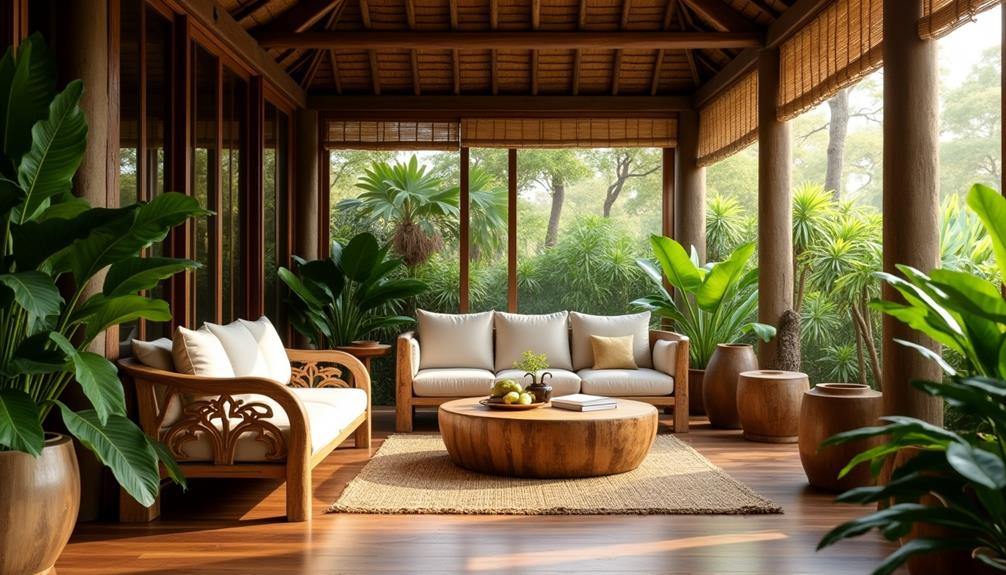
Coconut wood offers a twofold advantage: it's not only environmentally friendly but also visually striking.
You'll appreciate its unique grain patterns and rich colors that enhance any interior design.
Additionally, incorporating elements like the Indonesian decor mask can further celebrate the region's cultural heritage.
Environmental Benefits of Coconut
When you consider sustainable materials for interior design, coconut wood stands out for its remarkable environmental benefits. This unique material, a byproduct of aging coconut palms, plays a vital role in promoting a circular economy by reducing waste. Instead of discarding these trees after their productive life, coconut wood offers a sustainable solution that aligns perfectly with the ethos of luxury tropical design aesthetics.
Here are some key environmental advantages of coconut wood:
- Lower Carbon Footprint: It requires less energy to process than traditional hardwoods, which helps reduce carbon emissions.
- Pest and Decay Resistance: Its natural resistance minimizes the need for harmful chemical treatments, improving indoor air quality.
- Support for Biodiversity: By choosing coconut wood, you're backing sustainable forestry practices that help preserve Indonesia's rich biodiversity.
Embracing coconut wood not only enhances your interior spaces but also contributes positively to the environment.
It's a win-win for both design enthusiasts and eco-conscious consumers. By incorporating this sustainable material into your projects, you play a part in responsible land use and promote a greener future.
Choose coconut wood, and make a difference today!
Unique Aesthetic Appeal
Celebrating its rich, warm tones and distinct grain patterns, coconut wood brings a unique aesthetic appeal to interior spaces. This byproduct of aging coconut palms not only enhances the beauty of your home but also serves as an eco-friendly choice for design.
Traditional Indonesian Style Home Decor often incorporates materials like coconut wood, showcasing its versatility in both modern and traditional settings. You'll find that coconut wood's intricate patterns and hues create a visually striking contrast, whether you're aiming for a modern look or embracing traditional designs.
Using coconut wood in your furniture and decor means you're reducing waste from the coconut industry, making a sustainable statement in your interiors. Its natural durability adds to its charm; it stands up against moisture and pests, making it perfect for everything from flooring to unique pieces of furniture.
Moreover, because coconut wood is sourced locally in Indonesia, it boasts a low carbon footprint, minimizing transportation emissions. This versatility allows you to blend contemporary style with cultural heritage seamlessly.
Reclaimed Wood
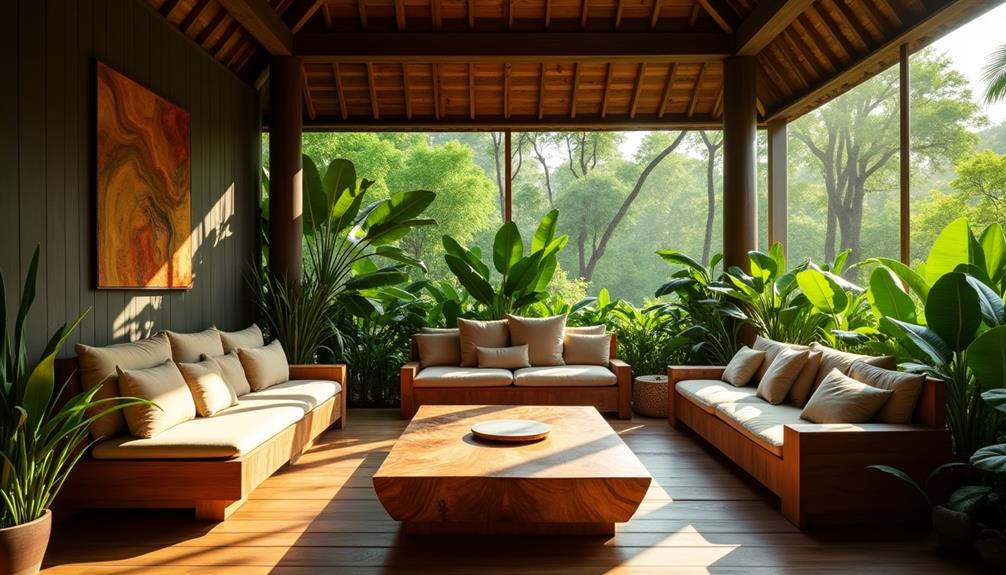
Over the years, reclaimed wood has emerged as a popular choice for Indonesian interiors, offering a sustainable alternative to traditional timber. By sourcing reclaimed wood from old buildings, furniture, and other structures, you're not only reducing the demand for new timber but also minimizing deforestation.
This eco-friendly option enhances your space with unique character and history, making each piece a conversation starter. Additionally, reclaimed wood can be seamlessly integrated into tropical villa plans, allowing for a warm, inviting atmosphere that complements the natural surroundings.
Here are some compelling reasons to evaluate reclaimed wood for your interiors:
- Environmental Impact: Using reclaimed wood lowers carbon footprints since it often requires less energy for processing than new wood.
- Local Economy Support: By incorporating reclaimed wood, you promote sustainable practices that benefit local economies and reduce landfill waste.
- Credibility in Design: Reclaimed wood products can qualify for sustainability certifications like the Forest Stewardship Council (FSC) label, adding credibility to your design projects.
Incorporating reclaimed wood into your interiors not only creates stunning aesthetics but also aligns your choices with sustainable living, making a positive impact on the environment and your community.
Thatch Roofing
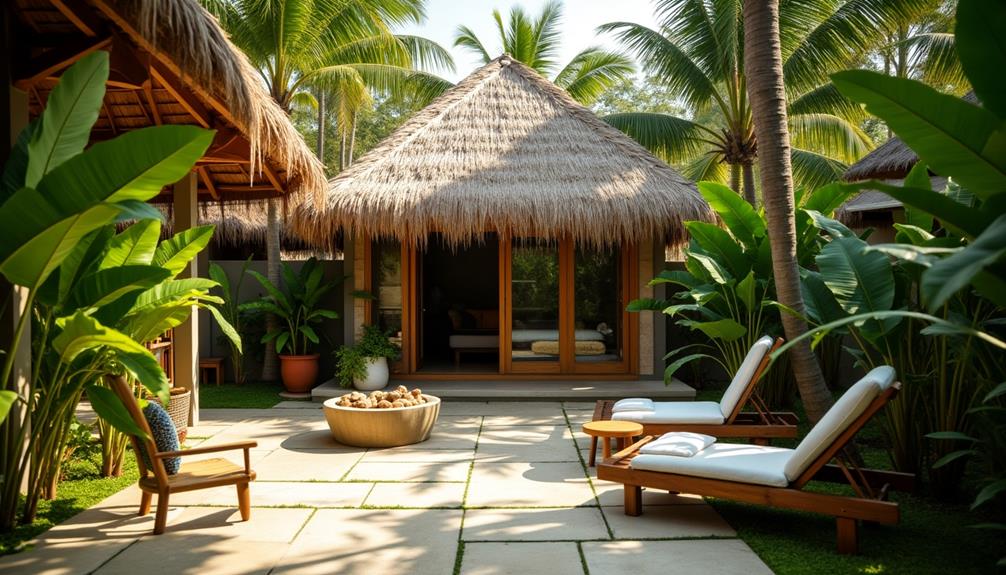
Thatch roofing offers an eco-friendly solution for your Indonesian interiors, as it utilizes natural materials like straw, reeds, and palm leaves. This sustainable roofing option provides excellent insulation, helping to maintain comfortable indoor temperatures in Indonesia's tropical climate.
By choosing thatch, you're embracing a biodegradable alternative that aligns with sustainable construction practices, minimizing your environmental impact compared to synthetic materials. Importantly, this roofing style is reminiscent of the significance of Bali roof style, which showcases local craftsmanship and contributes to cultural heritage.
Not only does thatch roofing integrate traditional aesthetics, often seen in Balinese architecture, but it also contributes to the cultural heritage of the region. When you opt for thatch, you enhance your home's charm while supporting eco-friendly design.
Another significant advantage is the reduction in energy costs. Thatch roofing improves thermal performance, decreasing your reliance on artificial cooling systems, which is both economical and sustainable.
With proper maintenance, you can expect your thatch roof to last between 15 to 25 years, making it a durable choice when installed correctly.
Incorporating thatch roofing into your interiors not only enriches your space aesthetically but also reflects a commitment to sustainable living and environmental stewardship.
Recycled Plastic
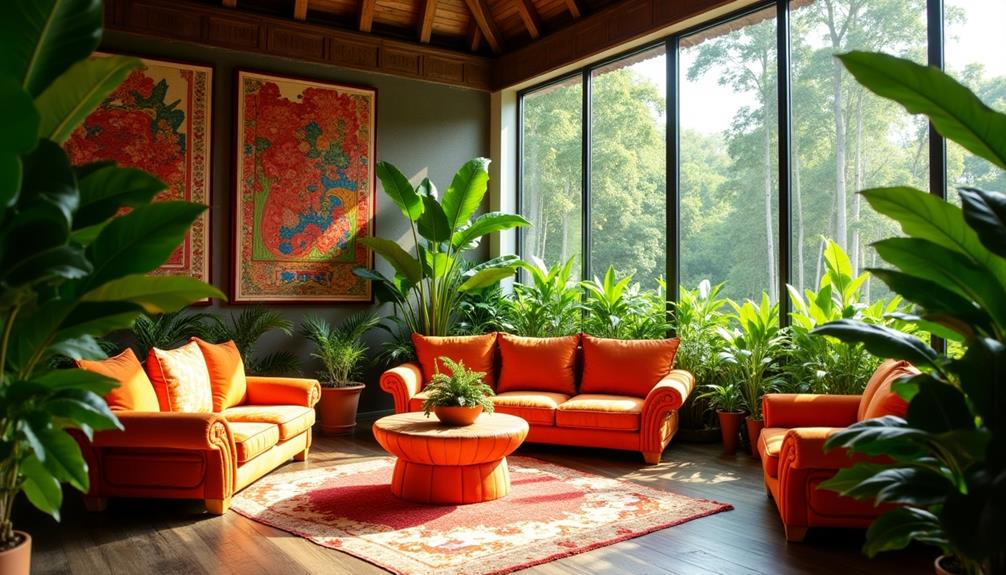
Recycled plastic offers a range of benefits for your interior spaces, from reducing waste to lowering your carbon footprint.
You'll find innovative product applications that not only enhance aesthetics but also provide durability for everyday use.
Benefits of Recycled Plastic
The growing trend of using recycled plastic in Indonesian interiors offers numerous benefits that make it an attractive option for eco-conscious consumers. By choosing recycled plastic, you're not only enhancing your space but also contributing to a more sustainable future.
Here are some key advantages:
- Environmental Impact: Utilizing recycled plastic helps divert millions of tons of plastic from landfills and oceans, tackling the significant challenge of plastic waste, which accounts for about 10% of global waste.
- Lower Carbon Footprint: Products made from recycled plastic have a reduced carbon footprint, as the recycling process uses less energy and can cut greenhouse gas emissions by up to 70%.
- Durability and Practicality: Recycled plastic is resistant to moisture, making it ideal for various interior applications, including flooring and furniture. It's lightweight and easy to maintain, ensuring lasting quality in your home.
As consumer interest in sustainable materials surges, incorporating recycled plastic into your interiors not only aligns with these trends but also supports a healthier planet.
Your choices can make a difference, turning your space into an eco-friendly haven.
Innovative Product Applications
How can you transform your interior spaces while making a positive environmental impact? One way is by embracing innovative approaches that utilize recycled plastic. This sustainable alternative has gained traction in Indonesian interiors, offering exciting applications like furniture, flooring, and decorative elements.
By using recycled plastic, you not only reduce reliance on virgin materials but also actively minimize plastic waste, contributing to the circular economy.
Imagine beautiful furniture that mimics traditional materials, providing aesthetic appeal while remaining durable and resistant to weather and pests. These products are perfect for both indoor and outdoor settings, allowing you to create versatile spaces without compromising style.
Thanks to advancements in manufacturing techniques, post-consumer plastic waste can be transformed into high-quality, customizable interior products, giving architects and designers enhanced design flexibility.
With increasing consumer awareness and demand for sustainable options, collaborations between Indonesian manufacturers and international brands are promoting recycled plastic materials in interior design projects.
Environmental Impact Considerations
Embracing innovative product applications not only enhances your interior spaces but also carries significant environmental benefits.
By incorporating recycled plastic into your designs, you actively contribute to mitigating the global plastic waste crisis. This choice helps divert approximately 8 million tons of plastic waste from oceans each year, addressing the dire need for sustainable solutions.
Consider these key environmental impact aspects of using recycled plastic:
- Energy Efficiency: Production of recycled plastic can reduce energy consumption by up to 60% compared to virgin materials, resulting in lower carbon emissions.
- Cost-Effectiveness: Integrating recycled plastic in furniture design can lead to a 50% reduction in material costs, making sustainable options more accessible for manufacturers.
- Durability: Products made from recycled plastics often have a longer lifespan and require less maintenance, promoting sustainability through durability and reducing waste.
Natural Fiber Textiles
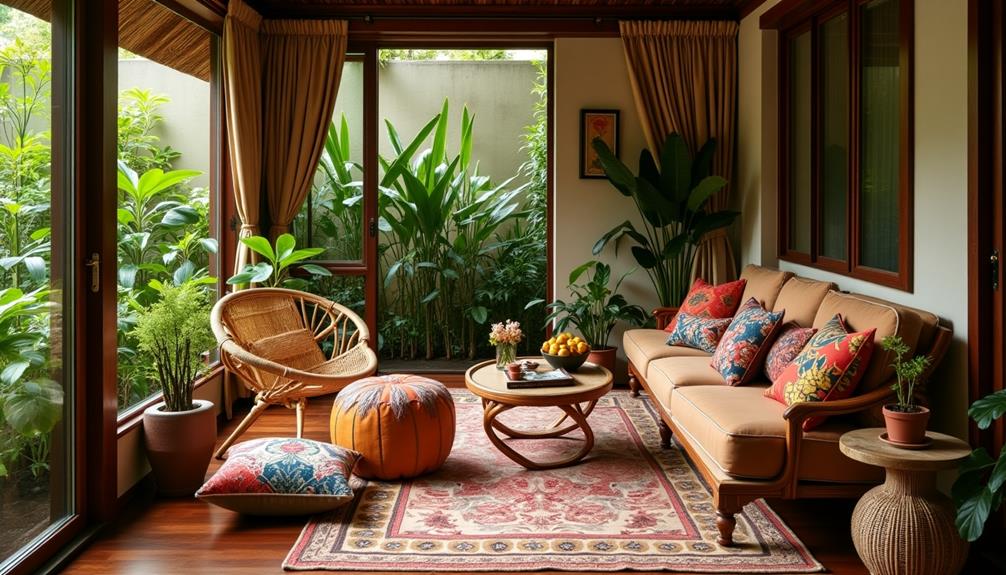
Natural fiber textiles, like jute, cotton, and hemp, are becoming essential elements in Indonesian interiors, thanks to their eco-friendly properties. These materials are not only biodegradable but also utilize natural resources sustainably, reducing the environmental impact compared to synthetic fibers.
Jute, with its durability and versatility, is perfect for rugs, curtains, and upholstery. Organic cotton production is on the rise in Indonesia, reflecting a growing demand for materials that support sustainable farming practices. Meanwhile, hemp textiles stand out for their strength and resistance to mold and UV light, making them a smart choice for eco-conscious decorators.
Here's a quick comparison of these natural fiber textiles:
| Material | Key Benefits |
|---|---|
| Jute | Durable, versatile, ideal for interiors |
| Cotton | Supports sustainable farming |
| Hemp | Strong, mold-resistant, UV-resistant |
| All | Biodegradable, eco-friendly |
Rammed Earth
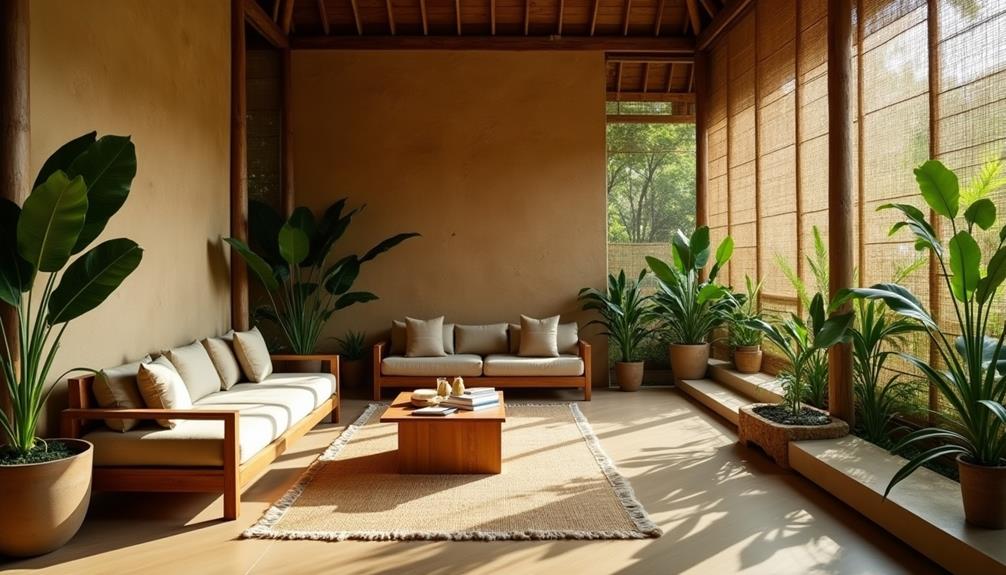
Rammed earth offers a sustainable alternative for building in Indonesia, harnessing the power of locally sourced materials like earth, gravel, and sand. This ancient construction technique compacts these natural materials to create durable walls with excellent thermal mass properties.
By maintaining consistent indoor temperatures, rammed earth markedly reduces energy usage, helping you minimize reliance on heating and cooling systems.
Consider these benefits of incorporating rammed earth into your sustainable interior:
- Low Energy Production: The process of creating rammed earth requires minimal energy compared to conventional materials, resulting in a lower carbon footprint.
- Fire Resistance: Rammed earth walls are highly fire-resistant, ensuring safety while enhancing occupant comfort.
- Sound Insulation: These walls offer excellent sound insulation, making your interior spaces more peaceful.
With a resurgence of interest in eco-friendly design trends, using rammed earth aligns perfectly with your desire for sustainability.
By choosing this material, you're not just building a home; you're supporting environmental sustainability while embracing traditional building techniques that utilize locally sourced materials.
It's a win-win for you and the planet.
Stone
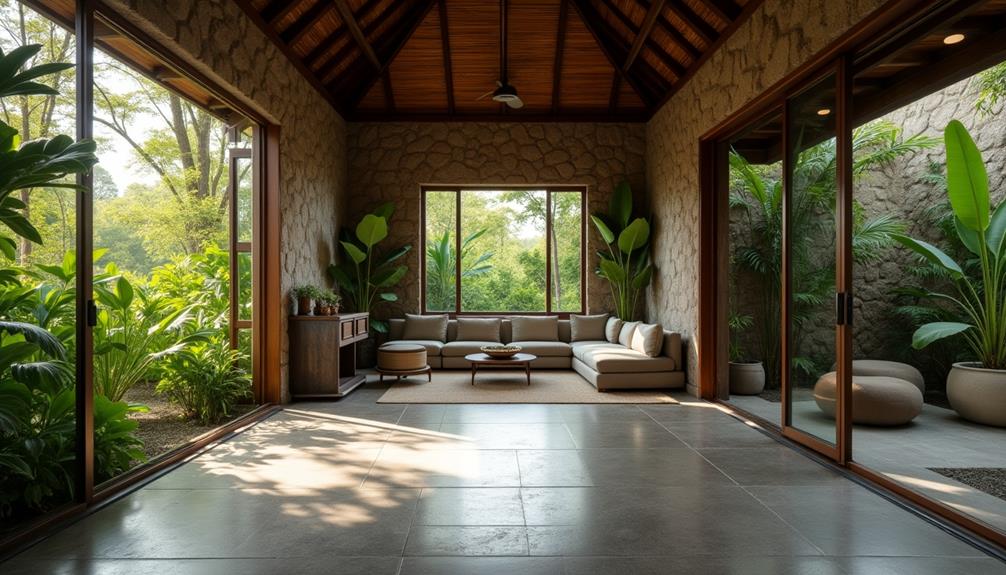
Building on the sustainable practices highlighted by rammed earth, stone emerges as another excellent choice for Indonesian interiors. This durable and natural material not only adds aesthetic appeal but also offers structural integrity in applications like flooring, countertops, and wall cladding.
You'll find options like granite, marble, and volcanic stone, with volcanic stone being particularly popular due to its unique textures and colors from Indonesia's rich geological activity.
By opting for locally sourced stones, you minimize transportation emissions, which helps lower your carbon footprint and supports local economies where stone quarries operate.
Stone materials also boast low embodied energy compared to other building materials, making them an environmentally friendly choice when you consider extraction, processing, and transportation impacts.
To guarantee your stone surfaces last, proper sealing and maintenance are essential. This enhances their longevity and resistance to moisture and staining, making them ideal for various interior applications in tropical climates.
Choosing stone as one of your sustainable materials not only enriches your space but also aligns with eco-friendly practices, making a positive impact on both the environment and your community.
Hemp
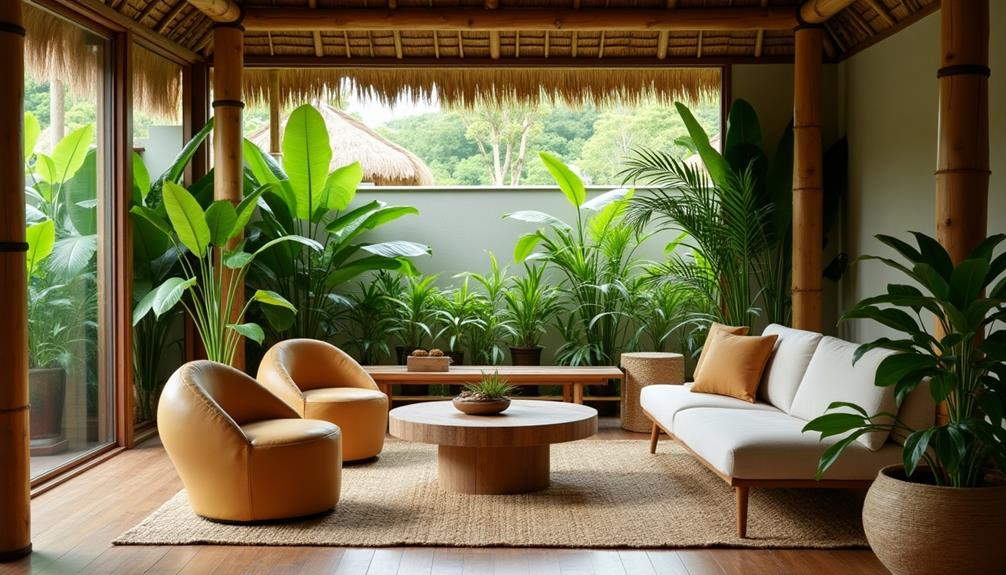
Sustainability is at the forefront of modern interior design, and hemp stands out as a remarkable option for creating eco-friendly spaces. This highly sustainable material can grow up to 15 feet tall in just three to four months, requiring minimal water and no pesticides. Its fibers are incredibly strong and durable, making hemp suitable for various applications, from textiles to furniture construction.
Consider the benefits of incorporating hemp into your interiors:
- Natural Anti-Microbial Properties: Hemp can improve indoor air quality by inhibiting mold and bacteria growth.
- Carbon Sequestration: Cultivating hemp absorbs significant CO2, helping to mitigate climate change.
- Biodegradable Products: Hemp-based items don't contribute to landfill waste, aligning perfectly with sustainable practices.
Using hemp in your designs not only enriches aesthetics but also promotes an eco-friendly lifestyle.
By choosing hemp, you're investing in sustainable materials that contribute to a healthier environment and a more sustainable future for Indonesian interiors.
Embrace hemp, and make a positive impact while creating beautiful, functional spaces.
Frequently Asked Questions
How Do I Maintain Sustainable Materials in My Home?
To maintain sustainable materials in your home, regularly clean and care for them. Choose eco-friendly cleaning products, avoid harsh chemicals, and repair any damage promptly to extend their life and reduce waste.
Are Sustainable Materials More Expensive Than Traditional Options?
Sustainable materials can sometimes cost more upfront, but they often save you money in the long run through durability and energy efficiency. You'll find that investing in them pays off over time.
Where Can I Find Sustainable Material Suppliers in Indonesia?
You can find sustainable material suppliers in Indonesia by researching online directories, visiting local trade shows, or connecting with eco-conscious design firms. Networking with industry professionals can also lead to valuable recommendations and insights.
What Certifications Should I Look for in Sustainable Materials?
When choosing sustainable materials, look for certifications like FSC, GOTS, and LEED. These guarantee responsible sourcing, organic practices, and energy-efficient production. Checking for these labels can help you make environmentally friendly choices in your projects.
Can Sustainable Materials Improve Indoor Air Quality?
Imagine your home as a breathing organism. Sustainable materials can enhance indoor air quality by reducing harmful pollutants, allowing your space to exhale freshness. You'll notice the difference in comfort and health almost instantly.
Conclusion
By choosing sustainable materials for your Indonesian interiors, you're not just enhancing your space; you're also supporting the environment and local communities. Imagine decorating your home with bamboo that once grew in your backyard or reclaimed wood from a family home. Each piece tells a story, connecting past and present. As you create a cozy haven, you're making a difference—transforming your living space into a reflection of your values and a tribute to the beauty around you.
-

 Home Decor & Design4 months ago
Home Decor & Design4 months agoRustic Wall Art Galore: Find Your Style
-

 Home Decor & Design4 months ago
Home Decor & Design4 months agoRustic Lighting Delights for Every Room
-
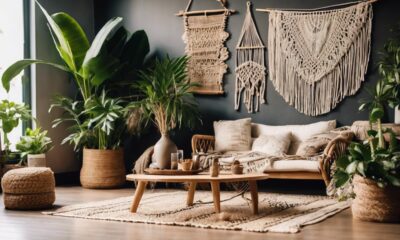
 Home Decor & Design4 months ago
Home Decor & Design4 months agoDiscover Boho Home Accents and Natural Elements
-

 Home Decor & Design4 months ago
Home Decor & Design4 months agoCharming Farmhouse Curtain Styles Galore
-

 Home Decor & Design4 months ago
Home Decor & Design4 months agoDiscover Charming Farmhouse Lamp Styles
-

 Home Decor & Design3 months ago
Home Decor & Design3 months agoCoffee Table So Plush, You'll Want to Nap On It
-

 Lifestyle4 months ago
Lifestyle4 months agoAstrology’s Role in Predicting Star Appeal & Charm
-

 Home Decor & Design4 months ago
Home Decor & Design4 months agoDiscover Rustic Charm in Vintage Home Decor












